Behind every man there’s a great woman. Be it the consorts or the princesses, the royal ladies of Joseon also played an important part in shaping the dynasty to become one of the longest dynasties ever existed. Although they were not on the front line when it comes to governing the country, they were the closest supporters of their husbands and their sons as the rulers of the nation. Without them, the 500-year Joseon history would be incomplete. Their existence complemented the lives of the royal palace and helped to continue the long line of heirs in the royal family of Joseon.
This is the list of ladies of the Royal House of Joseon, including the queens consort, the royal concubines, the princesses, and the princesses consort. You can simply click the name with hyperlink, which will take you to the short (or sometimes long) biography of the figure, or use Ctrl+F to find the name, but the spellings might vary. This page is still under construction and it will be updated from time to time! 😉
Last update: 23.05.2020
| Ruler | Consorts | Issues |
|
1. Taejo |
|
|
| 2. Jeongjong |
|
|
| 3. Taejong |
|
|
| 4. Sejong |
|
|
| 5. Munjong |
|
|
| 6. Danjong |
| |
| 7. Sejo |
|
|
| 8. Yejong |
|
|
| 9. Seongjong |
|
|
| 10. Yeonsangun |
|
|
| 11. Jungjong |
|
|
| 12. Injong |
| |
| 13. Myeongjong |
|
|
| 14. Seonjo |
|
|
| 15. Gwanghaegun |
|
|
| 16. Injo |
| |
| 17. Hyojong |
|
|
| 18. Hyeonjong |
| |
| 19. Sukjong |
| |
| 20. Gyeongjong | ||
| 21. Yeongjo |
|
|
| 22. Jeongjo |
|
|
| 23. Sunjo |
|
|
| 24. Heonjong |
| |
| 25. Cheoljong |
|
|
| 26. Gojong |
| |
| 27. Sunjong |
|
Notes – Royal titles used during Joseon Dynasty (details here):
- Empress – hwanghu (황후) ~Korean Empire
- Grand Royal Queen Dowager – daewangdaebi (대왕대비)
- Royal Queen Dowager – wangdaebi (왕대비)
- Queen Dowager – daebi (대비)
- Queen Consort –
- wangbi (왕비)
- posthumous: wanghu (왕후)
- first queen: jeongbi (정비)
- succeeding queen: (계비)
- Grand Internal Princess Consort – budaebuin (부대부인) *king’s mother
- Internal Princess Consort – bubuin (부부인) *queen’s mother
- Crown Princess – sejabin (세자빈)
- Grand Princess Consort – bubuin (부부인)
- Princess Consort – gunbuin (군부인)
- Princess –
- legitimate: gongju (공주),
- illegitimate: ongju (옹주)
- Grand Heir Consort – sesonbin (세손빈)
- Royal Concubine: hugung (후궁)
- Bin (빈) – 1st senior rank
- Gwiin (귀인) – 1st junior rank
- Soui (소의) – 2nd senior rank
- Sukui (숙의) – 2nd junior rank
- Soyong (소용) – 3rd senior rank
- Sukyong (숙용) – 3rd junior rank
- Sowon (소원) – 4th senior rank
- Sukwon (숙원) – 4th junior rank
- Crown Prince’s concubines:
- Yangje (양제) – 2nd junior rank
- Yangwon (양원) – 3rd junior rank
- Seunghwi (승휘) – 4th junior rank
- Sohun (소훈) – 5th junior rank
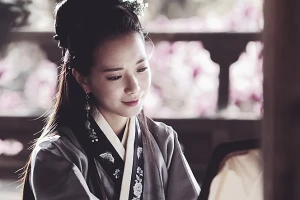
Born as the third daughter of Taejo, Princess Kyeongsoon/Kyungsoon (경순공주) was one of the children of Queen Sindeok, the other two being her younger brothers, Grand Prince Muan and Grand Prince Uian (then the Crown Prince). She was married to Yi Je. Her husband was killed together with her brothers during the First Strife of Princes and she herself was forced to become a nun by her half brother, Grand Prince Jeongan (Taejong). She passed away in 1407.
Portrayed by:
- Kim Da-ye in the movie Empire of Lust/ Age of Innocence (2015)
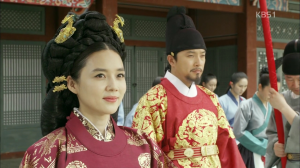
Regarded as one of the politically savvy queens among those of Joseon Dynasty like Queen Jeonghee and Queen Munjeong, Queen Wongyeong or Lady Min, was born as the second daughter of Min Je from the Yeoheung Min clan in 1365 and married Yi Seong-gye’s fifth son, Yi Bang-won in 1382. She weathered all the events prior to the founding of Joseon Dynasty and crowned Princess Jeongnyeong (정녕옹주) when her husband became Prince Jeongan. Instead of choosing Yi Bang-won as his heir, Yi Seong-gye, then Taejo, selected Yi Bang-seok, his second son with his second queen Queen Sindeok as the Crown Prince. With her daring and brave personality, Lady Min persuaded her husband to start a coup but Yi Bang-won hesitated to fight against his own father. When Jeong Do-jeon ordered for all the private soldiers and the firearms to be handed over to the government, Lady Min hid the private soldiers and firearms belonging to her family at her house. Seizing the opportunity when Taejo was lying in his sickbed, Lady Min gave the firearms to Yi Bang-won and persuaded him into carrying out the coup. Hence, Yi Bang-won, together with her brothers Min Mu-jil and Min Mu-gu, led the attack to kill Queen Sindeok’s sons Yi Bang-beon and Yi Bang-seok, son-in-law Yi Je, Jeong Do-jeon, and Nam Eun in the event known as The First Strife of Princes.
Although Yi Bang-gwa became the next Crown Prince and then taking over the throne as Jeongjong after Taejo relinquished his seat to his second son, Yi Bang-won’s influence was seen as a threat by the fourth son of Taejo, Yi Bang-gan or Prince Hoean. Together with Park Po, Yi Bang-gan launched an attack against Yi Bang-won in 1400, which was later known as The Second Strife of Princes. The Min family, including Lady Min herself, fought against them and managed to quell Prince Hoean’s force. With Prince Jeongan being crowned as the Crown Prince and then the third king of Joseon, Taejong, she was known as Jeong Bin (정빈) as the Crown Princess and later Jeong Bi (정비) as the queen consort. She would have never thought that her family’s contribution became the very reason why Taejong saw them as threats to the throne and their close relationship to the Crown Prince (later known as Grand Prince Yangnyeong) caused Taejong to be cautious of their influence over the court once the Crown Prince ascended the throne. In 1406, it was said that Taejong would abdicate in that year and the Min brothers were elated to heard the news; but then, Min Mu-jil and Min Mu-gu were exiled to Jeju Island in the same year and then sentenced to death by poisoning in 1410. Her father, Min Je, passed away in 1408, possibly out of shock hearing about his sons’ exile.
The queen’s relationship with Taejong became worse because of Taejong’s concubines and the king, at one time, even avoided her quarters. When there were rumour of the queen abusing Taejong’s concubine Lady Kim hyo-bin and her son, Prince Kyeongnyeong, Taejong didn’t depose her; instead, her brothers Min Mu-hyul and Min Mu-hee were sentenced to death by hanging in 1416. Taejong’s decision to depose the Crown Prince and to put their third son, Grand Prince Chungnyeong as the heir at that time was strongly opposed by her, but in the end, Chunnyeong became the fourth king, Sejong the Great. She was known as Queen Dowager Hudeok (후덕왕대비) after Taejong relinquished the throne to Sejong. The queen who paved her husband’s path to the throne at the cost of her brothers’ lives passed away at the age of 56 in 1420, and she was then given the posthumous title Queen Wongyeong (원경왕후).
Portrayed by:
- Choi Myung-gil in the drama The Great King Sejong (KBS1, 2008)
- Go Na-eun in the drama Jeong Do-jeon (KBS1, 2014)
- Kim Sa-hee in the movie Empire of Lust/ Age of Innocence (2015)
- Gong Seung-yeon in the drama Six Flying Dragons (SBS, 2015)
Despite being the person whose marriage pioneered the selection process for the Prince consort or Bumagantaek, Princess Jeongseon (정선공주)’s life was sad right from the beginning. She was born in the midst of Queen Wongyeong’s rift with King Taejong in 1404, and the details regarding her birth were unknown since her mother hid her birth from her father until later. The Princess was the youngest legitimate daughter of King Taejong. After being rejected by his own friend with regard to Princess Jeongsin’s marriage proposal, King Taejong decided to select his son-in-law through a proper channel instead of sending a marriage proposal. He decided to pick someone from the rank 4~5 family and chose to forego the higher-ranked young men. Being a cautious man himself, King Taejong did not want to invite trouble through his own daughter’s marriage by choosing someone who might possess danger to the throne.
The chosen one was Nam Hwi, despite being a widow’s son. King Taejong made the decision with his concern on the future politics on the back of his mind: although Nam Hwi’s grandfather was the Prime Minister, the Prime Minister was already old, and the absence of Nam Hwi’s father made him an even more promising candidate. His family was considered illustrious but possessed little influence in politics. Princess Jeongseon was only 13 years old when she left for her private residence outside the palace. The Princess gave birth to her first son at the age of 16, but misfortune struck when Queen Wongyeong passed away on the following year. Two years later, King Taejong also died. The consecutive long mourning period tore the Princess and Nam Hwi apart, and Nam Hwi started to be addicted to gambling and having relationships with other women. His gambling addiction was so severe that at one time, King Sejong himself had to pay the debts. The Princess probably lived a lonely life then, and her husband did not even care if she was sick. She gave birth to a daughter at the age of 21 and passed away shortly after in 1424. King Sejong mourned deeply for his unfortunate little sister who had to die young after living a heartwrenching life. Despite living a short life, Princess Jeongseon’s legacy lived through her children: her son Nam Bin fathered General Nam Yi, the loyal military personnel of King Sejo, and her descendants through her daughter included Shin Saimdang, the mother of Yulgok Yi Yi.
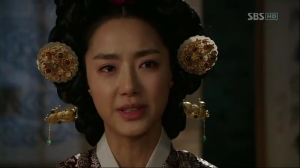
Considered a role model among the queens of Joseon Dynasty, Queen Soheon/Sohun (소헌왕후) was born as Lord Shim Ohn’s first daughter. She was chosen to become Prince Chungnyeon’s consort and bestowed the title Princess Kyeongsook (경숙옹주). Later, when Chungnyeon was formally invested as a grand prince, she became a princess (공주). After Taejong made Chungnyeon his official heir, her title was Crown Princess Consort Kyeong (경빈) and she’s usually addressed as Queen Gong (공비) after she was crowned the nation’s queen consort. Just like Taejong’s wife Queen Wonkyeong, she had to experience the most heart-wrenching event, which was to witness her family’s execution. It was done by Taejong to avoid any possible power struggle with the royal in-laws’ families. Her father and her uncles were killed; her relatives, including her mother, were demoted to lower class slaves. There were suggestions to strip her off her position as the queen, but it did not happen since she already gave birth to two princes at that time. Although it was a difficult time for her, she remained understanding and supported her husband, the fourth king of Joseon, Sejong. The Inner Court was at its most peaceful under her care and even the king himself praised her credibility as the leader. She was said to have a gentle and kind appearance but withheld great adherence to laws and code of conduct. She bore eight princes and two princesses from her marriage, including Munjong and Sejo.
Portrayed by:
- Lee Yoon-ji in the drama The Great King Sejong (KBS1, 2008)
- Jang Ji-eun in the drama Tree with Deep Roots (SBS, 2011)
- Lee Mi-do in the movie I am the King (2012)
Lady Kim (휘빈 김씨) was Munjong’s first consort. Desperate to capture her husband’s heart, she used witchcraft to get the attention from Munjong, then the crown prince. Sejong and Queen Soheon found out about the matter, leading to her being deposed. Because of her crime of using the black magic, Sejong ordered her execution and she was sentenced to death by beheading, merely three years after her marriage.
Lady Bong (순빈 봉씨) was the second consort of the crown prince and married Munjong two years after Lady Kim had been deposed. She had a cold, distant relationship with her husband and hearing about Lady Kwon seunghwi (later Queen Hyeondeok) being pregnant, Lady Bong felt threatened that a concubine was carrying her husband’s child and she did not have any offspring yet. Sejong persuaded Munjong, who was the crown prince at that time, to pay more attention to his official consort and he did spend more time with Lady Bong, but then, she started to lie about her own pregnancy. She faked her miscarriage when Lady Kwon’s child died young. Later, she caught in the act of homosexual relationship with her maid Sossang and Sejong found out about it. Lady Bong was stripped off her royal title after the matter, plus there were many speculations about her pregnancy before, but Sejong spared her life for her father’s sake. However, her father fell ill and passed away two years after she left the palace.
Portrayed by:
- Yeo Min-joo in the drama The Great King Sejong (KBS1, 2008)
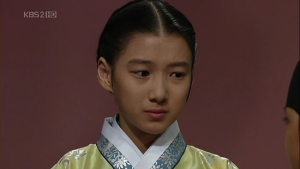
Princess Jeongso (정소공주) was the eldest daughter of King Sejong and Queen Soheon, so she was the elder sister to both King Munjong and King Sejo. Born when Sejong was still the Grand Prince Chunnyeong in 1412, she was referred to as wangnyeo agissi when her father became the Crown Prince and later conferred the title gongju when King Sejong ascended the throne. She was initially known as Princess Jeonghye (정혜공주), but the title was similar to King Taejong’s daughter who was also her superior, hence her title was changed to Jeongso. She was adored so much by King Sejong and he would make time despite his busy schedule to personally teach her writing. Unfortunately, she contracted measles a year before her planned coming-of-age ceremony and succumbed to death at the age of 13 in 1424. King Sejong was greatly saddened with her passing that he could not even continue his work for some time after her death. Her mourning saw the nation’s meritorious subjects as well as the top government officials lining up to pay their respects.
Portrayed by:
- Joo Da-young in the drama The Great King Sejong (KBS1, 2008)
Originally Munjong’s concubine of the seunghwi (junior 4th) rank, Lady Kwon was already raised to the yangwon (junior 3rd) rank and gave birth to two daughters when Munjong’s princesses consort were both deposed, one after another. Although she was made the official consort of the crown prince, it was recorded that Munjong wanted to make another concubine as his consort, but she was chosen in the end. She gave birth to the royal grandson (later Danjong) but passed away one day later. She was known as Crown Princess Hyeondeok (현덕빈) after her death and when Munjong became the king, she was posthumously referred to as Queen Hyeondeok (현덕왕후).
Portrayed by:
- Kang Hae-in in the drama The Great King Sejong (KBS1, 2008)
She entered the palace together with several other ladies, including Lady Kwon (Queen Hyeondeok), as Munjong’s concubines and they were all elevated to the rank of seunghwi. After the princesses consort were deposed, Munjong was close with Lady Hong at that moment, but Sejong decided that it would be better if Lady Kwon, who had given birth to a daughter and held a higher rank (yangwon) was to be selected as the new consort, plus she was older than Lady Hong. Munjong followed his father’s wish. After Munjong’s ascension to the throne, she was elevated to the rank gwiin and given the authority to become the leader of the Inner Court since the queen’s seat was empty. When Danjong took over his father’s place as the king, Lady Hong was elevated to the highest rank bin with the title suk (숙빈 홍씨). She stepped down from the position of the Inner Court’s leader when Danjong married her consort, Queen Jeongsun, and moved into Grand Prince Anpyeong’s house. It was unknown when or where she died since there were no records about it. Lady Hong had a daughter but the child passed away at the age of four.
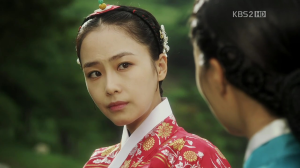
One of the most prominent figures to be featured in books about Joseon Princesses, Princess Kyeonghye (경혜공주) also appeared as a character in the drama The Princess’ Man. Born as the second daughter of King Munjong when he was still the Crown Prince in 1436, her mother Lady Kwon was just a concubine at that time. Hence, she was referred to as hyeonju. Her title was raised to gunju when her mother was made the Crown Princess, and she was known as Princess Pyeongchang 평창군주(平昌郡主) even after her marriage to Jeong Jong. She was raised under the care of her wet nurse, but the Princess lost her mother when she was only 6 years old since Crown Princess Hyeondeok passed away due to postnatal complications after giving birth to King Danjong. The Princess’ marriage was decided at a slightly later age of 15 because she did not want to leave her father by himself. However, her grandfather King Sejong passed away before the ceremony could go on, hence she had to oversee the 3-year mourning ritual before completing the wedding when she was 18. King Munjong soon passed away too, leaving behind the young King Danjong to take over the throne. The Princess and her consort, Jeong Jong, protected the young King with all their might, but her family ended up being embroiled in the bloody aftermath of Grand Prince Suyang’s takeover of the throne. Jeong Jong was banished and she gave birth away from home while following her husband in exile. Despite the repercussions, the family continued to rebel against King Sejo to find justice for King Danjong, which eventually led Jeong Jong to hang, drawn, and quartered to death. There were disputes regarding the historical facts since it wasn’t recorded that she became a slave; instead, there was a record stating that she shaved her hair and became a Buddhist nun after her husband’s death. She lived in poverty while raising her only son Mi-su, but King Sejo eventually granted special pardon to her family and called her back to the capital. She passed away during King Seongjong’s reign in 1474, outliving the person who drove her brother and husband to their deaths.
Portrayed by:
- Hong Soo-hyun in The Princess’ Man (KBS2, 2011)
Born as the only illegitimate issue of King Munjong who survived infancy, Princess Kyeongsook (경숙옹주)’s mother Lady Yang was the only Crown Prince’s concubine recorded with the title sachik 사칙(司則), which was the old term for the title 수칙(守則). Little was known about her life, other than her birth in 1439 her marriage with Kang Ja-soon when she was 16 years old. The couple lived a relatively quiet life without being mentioned in the Annals, but it was not until 28 years later that their names were brought up due to the issue of Kang Ja-soon’s remarriage. It was unknown when or why the Princess died, but it was presumably more than 12 years old prior to the issue of remarriage. It was during King Seongjong’s reign that the issue came up and Kang made an appeal for his second wife Lady Yi to be acknowledged as a legal wife, despite the rule to regard her only as a concubine. The debate continued and King Jungjong finally put an end to the matter by acknowledging Lady Yi as his legal wife, despite having a lower status and rank compared with Princess Kyeongsook. The Princess was entombed at a location below the area of Kang’s reserved spot for his mound, while Lady Yi’s spot was situated below the Princess’ tomb, signifying her lower status compared to Princess Kyeongsook.
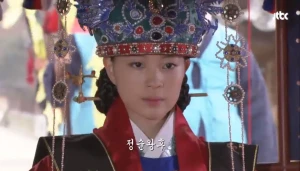
Marrying Danjong who was one year younger than her, Lady Song became the nation’s queen at the age of fifteen. When Danjong was forced to abdicate by Grand Prince Suyang, she became the queen dowager and addressed as Queen Dowager Indeok (인덕 왕대비), but the assassination plot by Six Martyred Ministers or sayuksin (사육신) affected Danjong as well, causing him to be demoted to the status of a prince and addressed as Prince Nosan. Lady Song was demoted to the status of a princess consort and thus, kicked out of the palace since her status would not allow her to live there. Her parents’ home was destroyed and she had to stay together with palace maids outside the city’s gate. She made her living by helping the palace maids to dye their clothes, barely surviving by herself. To make it worse, she wasn’t entitled to receive the food rations provided by Sejo’s family. But then, pitying Lady Song’s poor life, the women in her neighbourhood secretly made an arrangement to give her the supplies without the government’s permission.
She met her husband for the last time before he was exiled to Yeongwol and after receiving the news about his death, Lady Song would stand on a big rock after dinner, facing to the direction of Yeongwol and wailed for Danjong, praying for his soul to rest in peace. Shin Suk-ju wanted to make her his slave but Sejo issued an order, stating that she wasn’t allowed to do the slave duties even if her status was one. Since she basically could do nothing, she was sent to Jeongeobwon (정업원), where the royal concubines would go to live after their spouses’ death. She passed away at the age of 82 and the Sarim tried to restore the couple’s honour during Jungjong’s reign, but the king rejected the proposal. It was not until Sukjong’s reign when they were properly honoured and Lady Song was given the posthumous name Queen Jeongsoon/Jeongsun (정순 왕후). Her tomb was named Sareung, symbolizing her longing and affection for her husband Danjong, who died an unfair death.
Portrayed by:
- Jo Jung-eun in the drama Queen Insu (jtbc, 2011)
From a Grand Prince’s wife to a nation’s queen, Queen Jeonghui/Jeonghee (정희왕후) witnessed the bloody uprising of her husband, Grand Prince Suyang, to the throne as Joseon’s king Sejo. Born in the illustrious Papyeong Yoon clan, she married Sejo, then Grand Prince Jinpyeong, at the age of 11. She became the queen following Sejo’s ascension to the throne right after pressuring his nephew, Danjong, into abdication. She gave birth to Crown Prince Uigyeong, Yejong, and Princess Uisook, but it was unfortunate that she had to witness the death of her two sons. She became a regent during her ill son, Yejong’s reign and chose Prince Uigyeong’s son Seongjong to become the next ruler. Known as the Great Royal Queen Dowager Jaseong (자성 대왕대비) during her lifetime, she also became a regent during Seongjong’s early reign together with her daughter-in-law Queen Dowager Insu. Queen Jeonghee was the first Great Royal Queen Dowager who acted as a regent in Joseon. Her role was not limited to a dowager who sat behind the young king; in fact, Queen Jeonghee became an active advisor for the young Seongjong in his discussion with the ministers. Thanks to her decisive nature and good political sense during her regency years, the ministers praised her ability to maintain the harmonious atmosphere in the court. She passed away in the 14th year of Seongjong’s reign at the age of 66.
Portrayed by:
- Yang Mi-kyung in the drama The King and I (SBS, 2007)
- Kim Seo-ra in the drama The Princess’ Man (KBS2, 2011)
- Kim Mi-sook in the drama Queen Insu (jtbc, 2011)
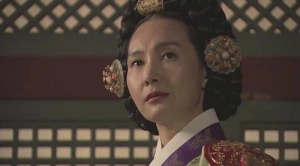
Widely known as Queen Dowager Insoo/Insu (인수대비) , she never became a queen consort herself during her whole life. Married to Sejo’s eldest son Crown Prince Uiryeong, the prince was sickly by the time he was designated as heir to the throne and passed away before he could become a king. Although Sejo gave her the permission to stay inside the palace with her young children (including her two sons Prince Wolsan and Prince Jasan), she initially refused the offer and Sejo specifically built Deoksugung (then a house for royal family instead of a formal palace) for her to stay. She did not get to be the nation’s queen but retained her influence as she paid close attention to her sons, for instance marrying off her second son, Prince Jasan to the daughter of Han Myeong-hoe, the Prime Minister at that time. After Yejong’s death, Queen Jeonghee declared Prince Jalsan as the next king instead of Yejong’s son Grand Prince Je-an, who was deemed too young to rule. She was addressed as a Queen Dowager but in reality, she never became one; it was a title bestowed for the mother of the king who was a queen consort herself. Prince Jasan had to become the official son of Yejong and Queen Ansoon in order for him to ascend the throne, so he was officially adopted as the former king’s son. Because of that reason, Queen Insoo couldn’t greet her son due to her status as a former crown prince’s consort, although she was the king’s birth mother.
The problem was solved by declaring her husband Crown Prince Uigyeong posthumously as a king (Deokjong) and she became the queen. But then, another problem was created since they had to determine who the second most powerful person was after Queen Jeonghui between Queen Insu and Queen Ansoon. Although Ansoon technically held the higher position than Insoo, the latter received the order from Sejo to protect Yejong and thus deemed more suitable to hold higher rank than the former. She was designated as the regents together with Queen Jeonghee (Great Royal Queen Dowager) and Queen Ansoon as Royal Queen Dowager during Seonjong’s reign before the young king took over the throne, reigning on his own. Queen Insoo became the Great Royal Queen Dowager during Yeosangun’s reign and witnessed the king’s tyrant act, including killing Seongjong’s concubines Jung gwiin and Eom gwiin before tearing their corpses to pieces after finding out that they were involved in his mother, Deposed Queen Yoon’s death. Yeosangun resented Queen Insoo because of Deposed Queen Yoon and pushed his sick grandmother, causing her death out of shock afterwards. She was posthumously referred to as Queen Sohye (소혜왕후).
Portrayed by:
- Yoon So-jung in the movie The King and the Clown (2005)
- Jeon In-hwa in the drama The King and I (SBS, 2007)
- Ham Eunjung & Chae Si-ra in the drama Queen Insu (jtbc, 2011)
Born as Han Myeong-hoe’s third daughter, she was chosen to become Yejong’s crown princess consort at the age of 16. She was adored by her father-in-law Sejo as she was a virtuous and beautiful woman. One year after her marriage, she gave birth to a Yejong’s first son, Grand Prince Inseong. Unfortunately, she contracted postnatal disease and died at a young age of 17. After her death, she was known as Crown Princess Jangsoon (장순빈), a posthumous title conferred by Sejo. Queen Jangsoon/Jangsun (장순왕후) was posthumously referred to as a queen when Seongjong ascended the throne. She was also Queen Gonghye’s older sister.
After Princess Jangsun passed away, Lady Han, who was born in the same year as the crown princess, was chosen to become the crown prince’s concubine of fifth junior rank sohun. Although she was not an official consort of the crown prince, she received treatment just like one. She gave birth to two daughter and two sons, but only one prince and one princess survived through childhood, one of them being royal grandson Grand Prince Je-an. The crown prince took over the throne as Yejong after Sejo’s abdication due to his illness, but Lady Han was the one nominated by the former king to become the queen consort. Since she was almost due at that time, guards were sent to her maternal home to guide the future queen. Her years as the queen was short as Yejong died 13 months after his ascension to the throne and to make the situation worse, Grand Prince Je-an was deemed too young to be invested as the next king. Hence, Queen Jeonghee and Han Myeong-hoe, the Prime Minister at that time, chose Prince Jasan, Han Myeong-hoe’s son-in-law and her nephew, to become her husband’s successor. Since she was the former king’s wife, she was legally the new king, Seongjong’s mother and received the title Royal Queen Dowager Inhye (인혜 왕대비). Conflicts happened when Seongjong’s birth parents were posthumously declared as king and queen as there was a need to determine the rank between Queen Dowager Inhye and Queen Dowager Insoo. They both became Great Royal Queens Dowager when Yeonsangun became the nation’s ruler. She passed away when she was 54 years old and posthumously known as Queen Ansoon (안순왕후).
Portrayed by:
- Lee Yeon-du & Kim Won-hee in the drama Queen Insu (jtbc, 2011)
The first queen consort of Seongjong, she was the youngest daughter of Han Myeong-hoe and Queen Jangsun’s younger sister, but her sister died several years before she was born. Her marriage to Prince Jasan, who was one year younger than her, was arranged by Sejo but it was said that Prince Jasan’s mother (later Queen Sohye) had set her goal to make Lady Han as her daughter-in-law. Prince Jasan’s status as the Prime Minister’s son-in-law was one of the factors which made him a favourable choice to sit on the king’s throne after his uncle, Yejong’s death. Lady Han was addressed as Princess Consort Cheonan (천안군부인) before she became the queen consort, being married to a prince. Queen Sohye was strict in front of his daughters-in-law but gave special treatment for Lady Han, to the point of personally overseeing her education. She could not bear any child for her husband but she did not show any jealousy towards Seongjong’s concubines and often sent them clothes and jewelry as gifts. She fell ill when she was 18 and went back to her maternal house to recuperate. She recovered but became seriously ill on the same year. Seongjong built a quarters especially for his queen to rest and even the Queens Dowager went there daily to visit her. Lady Han’s parents were also summoned to the palace to take care of her, but her health showed no improvement. She finally passed away few months later at a young age of 19 and was bestowed the posthumous title Gonghye (공혜왕후).
Portrayed by:
- Kim Hee-jung & Han Da-min in the drama The King and I (SBS, 2007)
- Lee Ji-woo in the drama Queen Insu (jtbc, 2011)
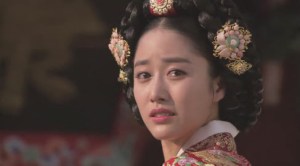
Several accounts believed her to be a palace maid before she became a royal concubine but in the Annals of the Joseon Dynasty, Lady Yoon entered the palace together with another Lady Yoon (who would later become Seongjong’s third queen consort Queen Jeonghyeon) and became the concubine of sukui rank. She was elevated to the status of a queen when Seongjong’s first wife, Queen Gonghye, passed away. Yeonsangun’s birth secured her position, but her temper and extreme jealousy caused her life as a queen to be short-lived. Seongjong’s complicated relationship with women caused her to be envious and each time he was not in his quarters, Queen Yoon suspected that he went to other concubines’ quarters. She even interrogated the other concubines and clawed her husband’s face during an argument. It left a scar on Seongjong’s face and along with the complains from the other concubines, Queen Dowager Insoo persuaded the king and Queen Yoon was deposed one day before her 24th birthday.
She didn’t get harsher punishment considering her status as the mother of the future king, but Seongjong’s concubines, Lady Jung gwiin and Lady Eom gwiin, instigated the other palace maids to make a false accusation towards Deposed Queen Yoon (폐비 윤씨), which led her to be sentenced to death by poisoning. She gave the cloth with her blood on it to her mother and asked for it to be given to her son. Yeonsangun eventually found out about the incident and ordered for the people involved to be sentenced to death, including Han Myung-hoe, who was decapitated posthumously. She was posthumously referred to as Queen Jeheon (제헌왕후) by Yeonsangun and her tomb was raised to the rank of a passing queen. She was featured in various productions but in the drama The King and I, Queen Yoon was a kind-hearted woman instead of the envious wife recorded in the history.
Portrayed by:
- Lee Joo-hee in the drama Dae Jang Geum (MBC,2003)
- Park Bo-young & Goo Hye-sun in the drama The King and I (KBS2, 2007)
- Jin Ji-hee & Jeon Hye-bin in the drama Queen Insu (jtbc, 2011)
- Woo Hee-jin in the drama Seven Day Queen (KBS2, 2017)
Entering the palace through a concubine selection, Lady Yoon became a royal concubine of the junior second rank, sukui when she was 12. Her father was involved in the process of deposing Queen Yoon, but it was not known whether Lady Yoon, being a 17 year old lady at that time, was involved in the scheme to overthrow the current queen. In the following year, she became Seongjong’s third queen consort. She gave birth to several daughters and a son, Grand Prince Jinseong, but all the princesses did not survive their childhood. Yeonsangun was raised by her as he was made her adopted son. She was respected by the young king and was bestowed various titles after becoming the queen dowager, but it all changed after 1504 Literati Purge or Gapja Sahwa (갑자 사화), in which Yeonsangun found out that Queen Jeonghyeon was not his birth mother and his birth mother was senteced to death by poisoning, leading to the large scale massacre of the Sarim faction. She underwent harsh treatment from the angry king and suffered from his rude behaviour despite being an elder to him. Yeonsangun’s era ended in 1506 after the coup organized by the officials and her only son, Grand Prince Jinseong, was made the next king, ruling as Jungjong. She passed away at the age of 69 and granted the posthumous title Queen Jeonghyeon (정현왕후). She was also known as Queen Dowager Jasun (자순왕대비) after her husband, Seongjong’s death.
Portrayed by:
- Lee Bo-hee in the drama Ladies of the Palace (SBS, 2001)
- Uhm Yoo-shin in the drama Dae Jang Geum (MBC,2003)
- Lee Jin in the drama The King and I (SBS, 2007)
- Go Jung-min & Han Bo-bae in the drama Queen Insu (jtbc, 2011)
- Kim Kyung-hwa in the drama Rebel Hong Gil Dong (MBC, 2017)
- Do Ji-won in the drama Seven Day Queen (KBS2, 2017)
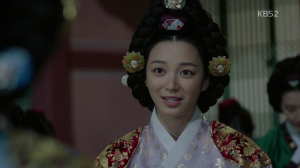
Posthumously known as Princess Consort Geochang (거창군부인), she was a descendant of Sejong’s son Grand Prince Imyeong on her mother’s side. She married Yeonsangun and became his consort at the age of 13. When he took over the throne, Lady Shin became the nation’s queen consort. One year before Yeonsangun was forced to abdicate, she was granted the title Queen Jeinwondeok (제인원덕) but due to her husband’s act, she did not get any posthumous name after her death. She was known simply as a princess consort after being deposed from her original position. Lady Shin lived until she was 66 years old, unlike her two sons, who were sentenced to death by poisoning right after the coup. She was interred beside Yeonsangun’s tomb and her tombstone stated her name Lady Shin of Geochang (거창군부인 신씨), where her title was derived from. Geochang was her clan’s name. She gave birth to four daughters and three sons, but only one princess and two princes survived their childhood.
Portrayed by:
- Park Ha-sun in the drama The King and I (SBS, 2007)
- Hong So-hee in the drama Queen Insu (jtbc, 2011)
- Song Ji-in in the drama Seven Day Queen (KBS2, 2017)
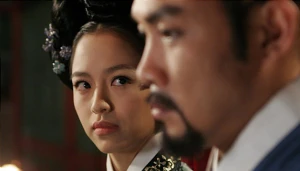
Born as daughter of a concubine, Lady Jang, or widely known as Jang Nok-su (장녹수), lived her early life as a slave of Grand Prince Je-an, Seongjong’s nephew. Due to her poverty, she had to sell herbody to make a living and had a son from her marriage with one of Grand Prince Je-an’s slaves before becoming a prostitute. She was famous for her beauty and art skills, and those words reached Yeonsangun’s ears. The king ordered for her to be brought into the palace, making her his concubine of the fourth junior rank sukwon. Yeonsangun showered her natal house with gifts including slaves and lands, and he even elevated her family’s status. Since Grand Prince Je-an was Nok-su’s previous owner, the king made it possible for the prince’s father-in-law to become a government officer. He was ridiculed by Nok-su herself, but Yeonsangun was blinded by his infatuation with her and even elevated her rank to sukyong (숙용 장씨). Nok-su used the king’s favour to help her family, for instance using her influence to raise her brother’s status and gave the position of a guard to her brother-in-law. She was cruel and ordered a courtesan’s death sentence before displaying the head publicly just because the courtesan accidentally stepped on her skirt. Jang Nok-su met a terrible ending after the rebellion to overthrow Yeonsangun’s tyrannical reign succeeded and she was beheaded alongside other people. The citizens threw stones and cursed at her dead body. Her only daughter, Yi Young-su, was also killed after the rebellion.
Portrayed by:
- Kang Sung-yeon in the movie The King and the Clown (2005)
- Oh Soo-min in the drama The King and I (KBS2, 2008)
- Jeon So-min in the drama Queen Insu (jtbc, 2011)
- Cha Ji-yeon in the movie The Treacherous (2015)
- Lee Honey in the drama Rebel Hong Gil Dong (MBC, 2017)
- Son Eun-seo in the drama Seven Day Queen (KBS2, 2017)
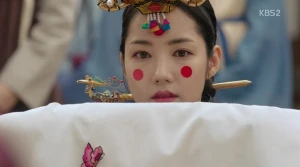
She was actually the first queen of King Jungjong, then Grand Prince Jinseong, and betrothed to him at the age of 13. After the coup to overthrow Yeonsangun was successful, Prince Jinseong, Yeonsangun’s half-brother, ascended the throne and Queen Dankyeong (단경왕후), then Lady Shin, became the queen. However, it did not last long as her father was the Deposed Queen Shin’s brother; plus the officials wanted to get rid of any person related to the tyrant. Jungjong was pressured into complying with the officials who put him on the throne and finally, he deposed Lady Shin from her position as the queen only seven days after she was declared so. A new queen was selected but died eight years later. Lady Shin’s supporters tried to suggest her reinstatement and sent an appeal, but the officials were against the idea and even caused her supporters to be exiled. Jungjong loved her dearly but the officials’ strong influence rendered him powerless, even for bringing his own wife into the palace. After Jungjong’s death, his son Injong gave a formal name for her residence: Deposed Queen’s Residence or pyebigung (폐비궁). She received help from Injong to make her life better and she passed away when she was 71. Without a posthumous name, she continued to be addressed as either Deposed Queen Shin (폐비 신씨) or Queen Shin (신비), and Yeongjo formally bestowed her the title Dankyeong posthumously during his 15th year of reign.
Portrayed by:
- Kim Hee-jung in the drama Ladies of the Palace (SBS, 2001)
- Park Shi-eun & Park Min-young in the drama Seven Day Queen (KBS2, 2017)
Lady Yoon was born into the illustrious Papyeong Yoon clan but her mother died early, so she was left under the care of her maternal aunt. When Jungjong became the king, she was made a royal concubine of the rank sukui. After the queen was deposed, her maternal uncle, Park Won-jong, who acted as regent alongside Jungjong, persuaded the king into making her his official consort and she was invested as the second queen consort of Jungjong. She gave birth to a daughter, Princess Hohye, but later contracted postnatal disease after giving birth to Injong and passed away. Posthumously known as Queen Jangkyeong (장경왕후), her brother was Yoon Im, leader of the Greater Yoon faction.
Portrayed by:
- Oh Ah-rang in the drama Ladies of the Palace (SBS, 2001)
She married Injong when he was the crown prince and became the queen consort once her husband took over the throne after Jungjong’s death. However, Injong passed away one year later and Queen Inseong (인성왕후) was elevated to the rank of Royal Queen Dowager with the title Gongui (공의왕대비) when Injong’s stepbrother, Myeongjong, became the next king. Since Myeongjong later died without an heir, Prince Haseong, an adopted son of the king and grandson of Jungjong, ascended the throne as Seonjo. Queen Inseong was not declared as the Grand Royal Queen Dowager; instead, Queen Insoon, who received the support of the officials, became the most senior member of the royal family despite having lower rank and also ruled as a regent alongside Seonjo. Queen Inseong died at the age of 64.
Portrayed by:
- Shin Eun-jung in the drama Ladies of the Palace (SBS, 2001)
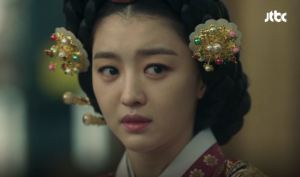
Lady Shim was actually a descendant of Queen Soheon’s natal family. She married Grand Prince Kyeongwon and later became a queen consort after her husband was declared as a king, ruling as Myeongjong. Queen Insoon/Insun (인순왕후) gave birth to her only child, Crown Prince Sunhoe, but the prince died in his 13th year. Her husband passed away few years later; left without an heir, she adopted Prince Haseong, who was crowned as Seonjo. She became the dowager and acted as a regent during Seonjo’s early reign. She ended her regency one year later and was bestowed the title Uiseong (의성왕대비). Queen Insoon passed away in Seonjo’s 8th year of reign and interred in the same tomb as her husband, Myeongjong, and her mother-in-law, Queen Munjeong.
Portrayed by:
- Ahn Yeo-jin in the drama King’s Face (KBS2, 2014)
- Jang Hee-jin in the drama Mirror of the Witch (jtbc, 2016)
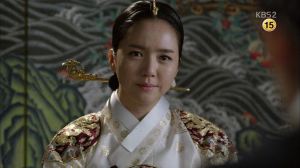
Seonjo’s first queen consort who married the king on his second year of reign, the queen faced an unfortunate fate as she was infertile and she could not bear any child. The royal concubine, Lady Kim Gongbin, received the king’s affection and further proved her inability, not to mention her life of being isolated by the royal relatives. In order to conceive, she built Buddhist temples all over the country for her to pray and made frequent donations to the temples. After Imjin War broke out, Seonjo fled to Uiju to seek protection, only bringing with him Lady Kim Inbin. The queen was separated from her husband and fled to Pyeonganam Island. The king and Lady Kim returned to the capital, but the queen decided to stay in Haeju. When the Second Invasion happened, Seonjo once again fled with Lady Kim Inbin but this time, the queen fled together with the Crown Prince, Prince Gwanghae. Her health deteriorated because of the constant moving from one place to another, and Queen Uiin (의인왕후) passed away at the age of 46 without any issue.
Portrayed by:
- Lee Hyo-chun in the drama King’s Woman (SBS, 2003)
- Hwang Mi-sun in the drama The Immortal Yi Sun-shin (KBS1, 2004)
- Im Ji-eun in the drama King’s Face (KBS2, 2014)
- Hwang In-young in the drama Jingbirok (KBS1, 2015)
After the mourning period for Queen Uiin ended, a new queen was selected. The queen, who was 19 at that time, married the 51-year-old king. One year after her marriage with Seonjo, she gave birth to Princess Jeongmyeong and three years later, Seonjo’s only legitimate son Grand Prince Yeongchang was born. After Prince Gwanghae became the king, a plan to overthrow the king came to light and to conceal the royal line’s weakness, her father was sentenced to death by poisoning while her only son was stripped of his royal title before being executed. She was deposed and confined to the palace. She was reinstated during Injo’s reign and became the Grand Royal Queen Dowager. She passed away at the age of 49 and was interred at Mokreung, together with Seonjo and Queen Uiin. It was later discovered that she left a book she penned to one of her court ladies, written during her confinement. The book, Gyechuk Ilgi, was considered Joseon Court Literature, together with Hanjungnok and Inhyeonwanghujeon. Queen Inmok (인목왕후) was well-known for her calligraphy and Princess Jeongmyeong inherited her parents’ calligraphy skills. The queen’s handwriting has been preserved until today as she copied a Buddhist sutra. She was addressed using various titles, such as Queen Dowager Jeongui (정의대비), Queen Dowager Soseong (소성대비), and Grand Royal Queen Dowager Myeongryeol (명렬 대왕대비).
Portrayed by:
- Hong Soo-hyun in the drama King’s Woman (SBS, 2003)
- Seo Yi-an in the drama Gu Am Heo Joon (MBC, 2013)
- Go Won-hee in the drama King’s Face (KBS2, 2014)
- Shin Eun-jung in the drama Splendid Politics/Hwajung (MBC, 2015)
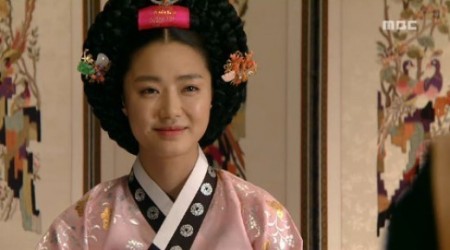
Lady Kim Gongbin (공빈 김씨), also known as Queen Gongseong (공성왕후), was a royal concubine of Seonjo and mother of Prince Imhae and Prince Gwanghae. She was granted the posthumous title as a queen and had her tomb elevated to the highest rank after Gwanghae was crowned as the king, but her status was revoked after Gwanghae was deposed. Born in 1553, she entered service as a palace attendant and received Seonjo’s grace, thus resulting in her status being elevated to that of a royal concubine of the senior third rank, soyong. She was raised to the rank gwiin after giving birth to her first son, Imhae, and later to the highest rank for a concubine, bin, following Gwanghae’s birth. Lady Kim was the sole object of Seonjo’s affection at that time and the king totally ignored the other concubines, In addition to that, he put complete trust in his favourite Lady Kim, to the point of killing anyone who was suspected of cursing and harming Lady Kim. This made him even more hostile towards his concubines.
However, that affection did not last longer, as Seonjo’s heart turned to Kim soyong (later Lady Kim in-bin), who served him with all her heart despite his cold treatment. Kim Inbin began to whisper the mistakes made by Kim Gongbin and Seonjo grew further from his former favourite. He showered his attention on Lady Kim Inbin, more than what he did for Lady Kim Gongbin before. She died in 1577, five years after giving birth to Gwanghae due to the postnatal disease. Although Imhae was the firstborn of the king, Gwanghae was chosen to become the crown prince instead of him due to his wild attitude, which was deemed unfit for a future king. Her father died on the battlefield during Imjin War and this caused Gwanghae’s position as the crown prince constantly in danger as he did not have people to support him.
Portrayed by:
- Jang Ji-eun in the drama Guam Heo Joon (MBC, 2013)
- Yoo Shin-ae in the drama Goddess of Fire, Jung-yi (MBC, 2013)
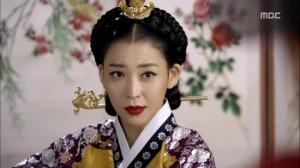
Born in 1555, Lady Kim Inbin (인빈 김씨) was actually a descendant of Taejong’s second son, Grand Prince Horyeong, on the maternal side of her family. Her sister’s daughter also became one of Prince Gwanghae’s concubines, Lady Shin sukwon. Her maternal cousin, Lady Yi sukui, was a concubine of Myeongjong, and Lady Kim was brought into the palace at Lady Yi’s request. Lady Kim caught the attention of Myeongjong’s wife, Queen Insoon, who found a liking in her. Queen Insoon, at that time Royal Queen Dowager Uiseong, suggested that her adopted son Seonjo take Lady Kim as his concubine. Hence, Lady Kim officially became a royal concubine of the junior fourth rank sukwon in the year 1573. She rose through the ranks of soyong, sukui, and gwiin to be declared as bin in 1604. Her relationship with Kim Gongbin was a strained one, and she used her influence over Seonjo to make the officials who supported Gwanghae to be exiled. She had the dream of putting her own son, Prince Shinseong, on the crown prince’s seat. The discord between Lady Kim Inbin and Gwanghae continued after he was declared the crown prince. She passed away at the age of 59. Lady Kim had four sons and five daughters from her relationship with Seonjo and her third son, Prince Jeongwon, was Injo’s father. It can be said that the later Joseon kings, from Injo to Sunjong, were all her descendants.
Portrayed by:
- Jung Shi-ah in the drama Guam Heo Joon (MBC, 2013)
- Han Go-eun in the drama Goddess of Fire, Jung-yi (MBC, 2013)
- Kim Gyu-ri in the drama King’s Face (KBS2, 2014)
- Kim Hye-eun in the drama Jingbirok (KBS1, 2015)
Born as the 21st child and the 10th daughter of Seonjo, she was actually the king’s sole legitimate daughter, born from Seonjo’s relationship with his second queen consort, Queen Inmok. She became his father’s favourite child but after Prince Gwanghae’s ascension to the throne, her male relatives, including her younger brother Grand Prince Yeongchang and her maternal grandfather, were charged with treason and executed, while the princess herself and her mother, Queen Inmok, were stripped off their status as royals and lived as commoners. To make it worse, both of them were confined to the Western Palace. They were restored to their original position when Injo took over the throne, but Princess Jeongmyeong (정명공주) was already 21 at that time, an age deemed too old for her to find a good match. The king set up a committee to find a royal son-in-law and despite the small number of candidates, Hong Joo-won was chosen to become Princess Jeongmyeong’s husband.
Injo even sent the tiles and lumber from Ingyung Palace to build the princess’ house and she enjoyed a luxurious life, with a big house on a large estate. Since she was afraid that Injo might suspect her, the princess devoted her life to needlework and household chores while intentionally avoiding any involvement with politics. Although she might have been under Injo and Grand Prince Bongrim’s suspicion because of an incident happening after Queen Inmok’s death, she managed to avoid any crisis by several officials’ assurance. She lived through the reign of three subsequent kings: Hyojong, Hyeonjong, and Sukjong. She passed away at the age of 83, leaving behind her seven sons and one daughter. One of her sons, Hong Man-hyeong, married Queen Inhyeon’s aunt while her first son, Hong Man-yong, was the great-great grandfather of Lady Hyegyeong.
Portrayed by:
- Han Min in the drama Three Musketeers (tvn, 2014)
- Lee Yeon-hee in the drama Splendid Politics/Hwajung (MBC, 2015)

Also known as Princess Consort Munseong (문성군부인), Deposed Queen Yoo (폐비 윤씨) was Prince Gwanghae’s queen consort. She was selected to become the consort of the prince. When Gwanghae became the crown prince, she was elevated to the crown princess’ rank at the age of 16. 16 years later, she became the nation’s queen consort. After Prince Neungyang overthrew her husband, she was deposed and exiled to Ganghwa Island, together with Gwanghae. Her son, the deposed Crown Prince, tried to escape with his wife but failed, resulting in them committing suicide. Lady Yoo passed away on the same year after seven months of living in exile.
Portrayed by:
- Han Hyo-joo in the movie Gwanghae: the Man Who Became the King (2012)
- Kim Hee-jung in the drama King’s Face (KBS2, 2014)
- Kim Hyo-seo in the drama Splendid Politics/Hwajung (MBC, 2015)
Marrying Prince Neungyang (능양군) when she was 17, she became the queen consort upon her husband’s ascension to the throne as King Injo. She passed away four days after giving birth to her sixth son. Injo wanted to bestow Myeongheon as her posthumous title, but Kim Sang-heon persuaded the king to change the name into Inryeol (인렬왕후): benevolence in (仁) and pillar yeol (烈).
Portrayed by:
- Lee Seung-ah in the drama Splendid Politics/Hwajung (MBC, 2015)
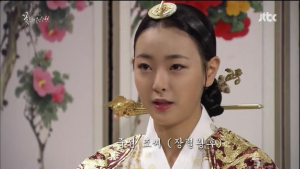
Three years after his first queen consort’s death, Injo chose a new consort to be crowned as his queen, who was the fifteen-year old Queen Jangryeol (장렬왕후). Her relationshop with Injo was not good due to the fact that she could not bear a son, thus she left the main palace at that time, Changdeok Palace, to live in Gyeongdeok Palace. After Injo’s death, she was elevated to the rank of a dowager and formally addressed as Queen Dowager Jaui (자의왕대비). Disputes happened during the death of her stepson, Hyojong, and his wife, Queen Inseon, where the factions argued on the duration in which Queen Jangryeol would have to wear the mourning attire or sangbok. The incident was known as Yesong Dispute (예송논쟁): for Hyojong’s funeral, it became an issue to determine whether the dowager should be mourning for three or one year, while for Queen Inseon, either one year or nine months. Hyeongjong became the king and Queen Jangryeol officially became the great royal queen dowager. Since she did not have any children, she led a solitary life until her death during Sukjong’s reign after living 50 years of her life as a woman of the royal palace.
Portrayed by:
- Kang Bu-ja in the drama Jang Heebin (KBS, 2003)
- Go Won-hee in Cruel Palace: War of the Flowers (jtbc, 2013)
- Lee Hyo-chun in the drama Jang Ok-jung, Live in Love (SBS, 2013)
- Kim Chae-bin in the drama Splendid Politics/Hwajung (MBC, 2015)
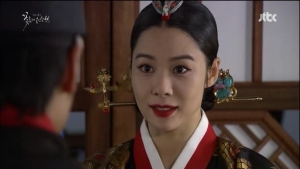
Coined as Joseon’s femme fatale, Lady Jo (귀인 조씨) was one of Injo’s royal concubines. She was initially arranged to become a maidservant of a lord’s daughter, but she was destined to live inside the palace. She used to serve Queen Inryeol’s brother-in-law and the queen was the one who arranged her to enter the palace. She caught Injo’s eyes and became his favourite concubine overnight; her rank also changed rapidly, from the lowest sukwon to sowon, soyong (she’s widely known as Lady Jo soyong), soui, and finally declared as a royal concubine of the junior first rank, gwiin. No one could beat her in terms of receiving the king’s affection; both Queen Jangryeol and Lady Jang sukui failed to receive Injo’s love. Her personality was that of a sensual but cunning woman and those who were in her bad book would not be safe in front of the king. Because of this, people inside the palace were very afraid of her.
Another well-known fact about her was the hate she harbored towards the Crown Prince Sohyeon’s family, particularly Crown Princess Minhoe. Since the day she reached the rank of soyong, he would badmouth them in front of Injo and it became a common thing for her to slander them with false accusations. Although there was no record of her involvement with Crown Prince Sohyeon’s death, her slanders did not stop even after the prince passed away. Because of that, Princess Minhoe suspected Lady Jo of poisoning her husband. Lady Jo grabbed this chance, accusing the princess of attempting to poison Injo, leading to the princess’ execution by poisoning. The acupuncturist who treated Prince Sohyeon before his death was Lee Hyung-ik, who was rumoured to be in a relationship with Lady Jo’s mother. There was even a record about this.
Later, it was rumoured that Lady Jo disturbed the relationship between Injo and Queen Jangryeol, with the intention to tear them apart. After Injo’s death, she was discovered to be involved in an attempt to put a curse on Queen Jangryeol and the queen’s niece. Kim Ja-jeom was her accomplice and he was executed. Hyojong decided to spare the life of Princess Hyomyeong, Lady Jo’s daughter, since she was not involved in the incident. Lady Jo was sentenced to death by poisoning and her mother Han-ok, who was also an accomplice, died before she could receive her punishment. There were officials suggesting for Lady Jo to be stripped off his position as a royal concubine but out of respect for his father, who treasured Lady Jo, Hyojong did not go through with the idea and she remained as a concubine of the junior first rank. She had two daughters and one son with Injo.
Portrayed by:
- Seo Hyun-jin in the drama Horse Doctor (MBC, 2012)
- Kim Hyun-joo in Cruel Palace: War of the Flowers (jtbc, 2013)
- Kim Min-seo in the drama Splendid Politics/Hwajung (MBC, 2015)
![[tvn] Three Musketeers E10.mp4_003949243](https://thetalkingcupboard.files.wordpress.com/2014/11/tvn-three-musketeers-e10-mp4_003949243.jpg?w=300)
Born as a daughter of the Left State Minister at that time, she was chosen to become Crown Prince Sohyeon’s wife at the age of 16. After Injo surrendered to Manchu after the Second Manchu invasion, the Crown Princess Kang (민회빈 강씨) followed Crown Prince Sohyeon, together with Grand Prince Bongrim (later Hyojong) and his wife (later Queen Inseon) to capital of Qing Dynasty Shenyang as hostages, following the condition in the peace treaty signed after the invasion. The detainment period ended eight years later and Princess Kang, together with her husband, went back to Joseon, but Injo’s constant suspicion about her possible rise for revolt caused discord between the king and Crown Prince Sohyeon. The crown prince died a sudden death only two months after his return and said to be hit with an inkstone by Injo before his death, but it was also rumoured that he had been poisoned. His burial was hastened without proper honoring according to his status despite Crown Princess Kang and the officials’ plea. Injo even banned the discussion regarding the death penalty sentenced to the doctor in charge of the prince.
Grand Prince Bongrim was declared the crown prince afterwards and Crown Princess Kang’s already strained relationship Lady Jo soyong (later Jo gwiin) became worse. She was accused of cursing Lady Jo and as a punishment, her brothers were exiled. Her palace maids were under the suspicion of poisoning Injo’s food and with the conclusion that it was under her order, Crown Princess Kang was sentenced to death by poisoning. Her brothers and her old mother were also executed. Following her death, her sons were exiled to Jeju Island, where the first son Suk-chul died of infection and second son Suk-rin died of an illness. Her last child Suk-gyun survived and later, Hyojong lifted his exile status. Her honour was finally restored during Sukjong’s reign thanks to the effort of the officials who fought for the injustice regarding her death.
Portrayed by:
- Kyung Soo-jin in the drama Horse Doctor (MBC, 2012)
- Song Sun-mi in the drama Cruel Palace: War of the Flowers (jtbc, 2013)
- Seo Hyun-jin in the drama Three Musketeers (tvn, 2014)
- Kim Hee-jung in the drama Splendid Politics/Hwajung (MBC, 2015)
Being the one and only daughter of Injo, she was loved by her father. Princess Hyomyeong (효명옹주) was the child of Injo and his concubine, Lady Jo gwiin. She was formally invested as a princess in her 11th year and the selection for her consort was held in the same year. Lady Jo arranged for her daughter to be matched with Kim Ja-jeom’s grandson, Kim Se-ryung, and in the end, they were married. She continued to live in the palace after the marriage and the princess only left to live outside the palace two years later. Injo cherished her deeply, resulting in her self-centered behaviour and bad relationship with her sister-in-law. After Injo’s death, Lady Jo was accused of putting curses on Queen Jangryeol and Hyojong, and Princess Hyomyeong admitted to burying unlucky things in the palace and Grand Prince Inpyeong’s residence with regard to the curse.
Although there were requests to put both Princess Hyomyeong and Kim Se-ryung under interrogation, only her husband was interrogated and later sentenced to death along with his grandfather Kim Ja-jeom. She was then stripped off her royal title, only known as Kim Se-ryung’s wife. The princess was exiled to Tongcheon but soon relocated to Icheon since the weather in Tongcheon was cold in that year. In 1655, Hyojong ordered for her place of exile to be moved again in order for her to live together with her siblings, Prince Sungseon and Prince Nakseon. Three years later, she was released from the sentence and continued to live under close surveillance until her death when she was 64 years old.
Portrayed by:
- Lee Young-eun & Lee Chae-mi in Cruel Palace: War of the Flowers (jtbc, 2013)

Queen Inseon (인선왕후) was originally selected to become Hyojong, then Grand Prince Bongrim’s wife. Bestowed with the title Princess Consort Pungan (풍안군부인), she followed her husband to Shenyang as hostages after Joseon surrendered to Qing Dynasty in the Imjin War. The couple stayed there for eight years before they were allowed to return to their homeland. Following Crown Prince Sohyeon’s sudden death after their return to Hanyang, Grand Prince Bongrim was invested as the new Crown Prince, and she herself became the crown princess. She became the queen after Injo’s death few years later. Hyojong’s death, and later Inseon’s death, caused a problem in determining the duration of the mourning period for them when it came to Queen Dowager Jaui (Queen Jangryeol), in the event known as Yesong Dispute. She had three sons and six daughters but two of her sons died in infancy. The son who lived became King Hyeonjong. She was addressed as Royal Queen Dowager Hyosuk (효숙왕대비) after her husband’s death.
Portrayed by:
- Kim Hye-seon in the drama Horse Doctor (MBC, 2012)
- Lee Moon-jung in Cruel Palace: War of the Flowers (jtbc, 2013)
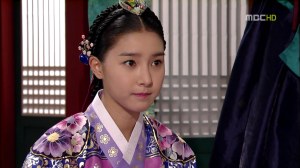
She was the fifth child of Hyojong. The princess married her husband Jung Je-hyun when she was 12 years old and gave birth to her only son Jung Tae-il, eight years later. However, her husband died on the following year, leaving her behind to become a widow at an early age. Her son died at a young age of 25 and Princess Sookhwi/Sukhwi (숙휘공주) passed away due to sickness at 55 years old. She was close to Sukjong and the king personally ordered for her ancestral rites to be prepared sufficiently after her death.
Portrayed by:
- Kim So-eun in the drama Horse Doctor (MBC, 2012)
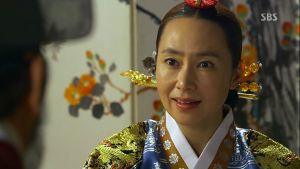
She was the queen consort of Hyeonjong ad mother of Sukjong. Queen Myeongseong (명성왕후) was a wise and intelligent figure, but her fierce personality was said to be the reason why her husband did not have any concubine throughout his lifetime. She became Royal Queen Dowager Hyeonryeol (현렬왕대비) when her son, Sukjong, was crowned as the king. Queen Myeongseong frequently intervened in the court, criticizing the Southerners (Namin) and framed Grand Prince Inpyeong’s sons (Princes Bokchang, Bokseon, and Bokpyeong) with the accusation of adultery with the palace maids. The reason was because she viewed them as threats to her son’s position.
However, there was no evidence to support her accusation and because of her claim, her father ended up being the suspect of initiating the slander against the princes. Queen Myeongseong took it up to herself and knelt outside her quarters, pleading for her son Sukjong to prove the princes’ crime. In the end, Sukjong exiled the three princes and the Southerners mocked her as a reincarnation of Queen Munjeong because of her intervention in the politics. Her father chose to confine himself in his house following the incident as he felt humiliated and he died because of severe depression.
After hearing about Sukjong’s relationship with a palace attendant (Lady Jang), Queen Myeongseong sent the attendant out of the palace since her low status would make the woman ignorant and wicked in her opinion. However, the real reason was the woman’s family background as Southerners made the queen thought that she entered the palace to become a spy for the Southerners. She set up a ceremony to pray for her son’s recovery after Sukjong felt unconscious. Queen Myeongseong was a firm believer of Shamanism and upon consulting with a shaman, decided to pray and get doused with water while wearing summer clothes although it was winter at that time. She was hit with a bad flu and died in the same year. Although the ministers urged for the shaman to be executed, Sukjong decided to exile her. Queen Myeongseong had four children: one son, Sukjong, and three daughters: Princesses Myeongseon, Myeonghae, and Myeongan.
Portrayed by:
- Kim Young-ae in the drama Jang Heebin (KBS, 2003)
- Yeh Soo-jung in the movie Shadows in the Palace (2007)
- Park Jung-soo in the drama Dong Yi (MBC, 2010)
- Lee Ga-hyun in the drama Horse Doctor (MBC, 2012)
- Kim Sun-kyung in the drama Jang Ok-jung, Live in Love (SBS, 2013)
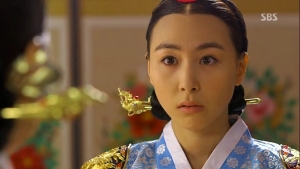
Sukjong’s consorts and concubines are famous subjects, be it in dramas or movies. It is probably because of the interesting conflict between factions which happened throughout his reign and the events also had impacts on his consorts. Queen Inkyeong (인경왕후) was the first queen consort of the king, getting married at the age of 10. When Hyeonjong passed away, Sukjong sat on the throne but due to his young age, his mother Queen Myungsung became a regent in his place. Two years later, Sukjong was deemed fit to rule on his own and Inkyeong was formally declared as the queen consort at the age of 16. She gave birth to two daughters but unfortunately, both died in infancy. When she was 20, Queen Inkyeong contracted smallpox and passed away without leaving behind any child.
Portrayed by:
- Kim Ha-eun in the drama Jang Ok-jung, Live in Love (SBS, 2013)
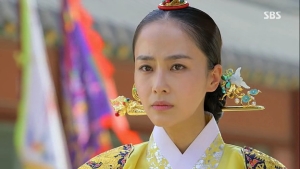
One year after Inkyeong’s death, a new queen consort was chosen: the daughter of Min Yoo-jung from the Yeoheung Min clan, addressed posthumously as Queen Inhyeon/Inhyun (인현왕후). She was chosen to become the consort after being recommended by Queen Myeongseong and her distant relative Song Si-yeol. Although she got strong supporters behind her, Inhyeon’s relationship with Sukjong didn’t turn out to be as expected, part of it because of Queen Myeongseong’s part in chasing out a court lady Sukjong loved. The court lady was no other than Lady Jang Hee-bin and in an attempt to control the inner court, Inhyeon brought in Lady Kim Young-bin as Sukjong’s new concubine to distract him from Lady Jang, but failed.
Lady Jang gave birth to a son (later Gyeongjong) and Sukjong wanted to make his son the official heir to the throne, Seoin, the Westerners supporting Queen Inhyeon, disagreed with his decision and the conflict caused the Westerners to be removed from their positions in the court, making way for their rival Namin or Southerners to yield their power. Queen Inhyeon was inflicted and as a result, she was deposed from her position as a queen consort in the event known as Gisa Hwanguk. Five years after being deposed, Sukjong brought in the Westerners to keep the Southeners in check but he had no intention of bringing back Queen Inhyeon to the palace; however, few days later, he changed his mind and ordered for her to be raised to the position of a queen consort again. Queen Inhyeon passed away a few years later and Lady Jang was accused of using witchcraft to kill her.
Portrayed by:
- Park Sun-young in the drama Jang Heebin (KBS, 2002)
- Park Ha-sun in the drama Dong Yi (MBC, 2010)
- Kim Hae-in in the drama Queen Inhyun’s Man (tvn, 2012)
- Hong Soo-hyun in the drama Jang Ok-jung, Live in Love (SBS, 2013)
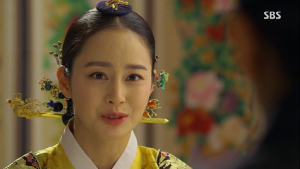
The famous Jang Heebin (희빈 장씨), or Lady Jang Ok-jung (장옥정), entered the palace as a palace maid and became Queen Jangryeol’s maid. She caught the attention of Sukjong, who frequented his grandmother’s quarters, but Queen Myeongseong, Sukjong’s mother, chased her out of the palace. She entered the palace again after Queen Myeongseong’s death. Lady Jang was appointed as a royal concubine of the fourth junior rank sukwon and she later, after she gave birth to Gyeongjong, was made a concubine of the highest rank bin. Sukjong wanted to make their son his official heir and angry at the Westerners protesting against his wish, demoted Inhyun to a commoner’s status. Lady Jang became the queen but she was later demoted to her original rank Heebin. She also gave birth to another son, Prince Seongsu. Shortly after Inhyeon’s death, Lady Jang was accused of cursing the late queen; because of that reason, Sukjong issued the order of sentencing her to death by drinking poison.
Portrayed by:
- Kim Hye-soo in the drama Jang Heebin (KBS, 2002)
- Yoon Se-ah in the movie Shadows in the Palace (2007)
- Lee So-yeon in the drama Dong Yi (MBC, 2010)
- Choi Woo-ri in the drama Queen Inhyun’s Man (tvn, 2012)
- Kim Tae-hee in the drama Jang Ok-jung, Live in Love (SBS, 2013)
- Oh Yeon-ah in the drama Jackpot/The Royal Gambler (SBS, 2016)
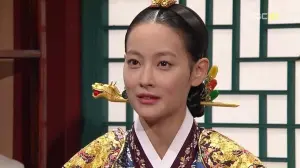
She became Sukjong’s consort after Queen Inhyeon’s death at the age of sixteen. Queen Inwon (인원왕후) became the Royal Queen Dowager during Gyeongjong’s reign and the Great Royal Queen Dowager during Yeongjo’s reign. Although her family was Soron, she changed her faction to Noron after Sukjong’s death. She was close with Lady Kim Youngbin and Lady Choi Sukbin, both being Sukjong’s concubines from the Westerners faction. She protected Prince Yeoning when he was under suspicion of treason and adopted him as her son after he was declared the heir to the throne during Gyeongjong’s reign. Queen Inwon played an important role in Yeongjo’s ascension to the throne and the king treated her like his own mother. She penned several books and lived until she was 71, also referred to using her title while she was alive, Queen Dowager Hyesun (혜순왕대비). She was interred in Seooreung, where Sukjong’s tomb with Queen Inhyeon, Myeongneung, was situated.
Portrayed by:
- Oh Yeon-seo in the drama Dong Yi (MBC, 2010)
- Kim Hae-sook in the movie Sado/The Throne (2015)
- Nam Gi-ae in the drama Haechi (SBS, 2019)
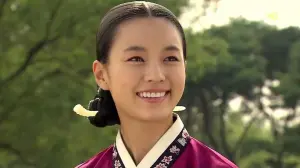
Choi Sukbin (숙빈 최씨) was one of Sukjong’s concubines. She was said to be a water maid (무수리) before she became a concubine, but another argument stated that she was possibly a palace maid working in the sewing department, chimbang (침방). One of the conversations she had with her son Prince Yeoning (Yeongjo) was about her experience working in the department. Although there was no exact date when she received Sukjong’s grace, she was raised to the rank sukwon in the same year she gave birth to her first son, Yeongsu; however, the young prince died two months after being born. Following Queen Inhyeon’s reinstatement in 1694, Lady Choi was promoted to the rank sukui and she gave birth to another prince in that year; that prince was Yeongjo. She was further raised to the ranks gwiin and finally bin in the same occasion where Danjong was reinstated to a king’s status posthumously.
She was close with Queen Inhyeon and reported the curse cast by Lady Jang that caused the queen’s death to Sukjong. There was rumour of Lady Choi becoming the next queen as Lady Jang was sentenced to death, but Sukjong’s new law prohibiting royal concubines to be elevated to the status of a queen made it impossible for her to be considered as a queen’s candidate. There were two of Sukjong’s concubines who were from the Westerners faction (서인): Lady Choi and Lady Kim gwiin (later Kim Youngbin). If the Westerners had to pick one of them to become the queen, Lady Choi would be rejected since she already had a son, who could be a source of problem regarding the succession issue (at that time, Lady Jang’s son was already the Crown Prince). That would make Lady Kim at advantage since she had no issue.
During her lifetime in the palace under the two queens consort, Lady Choi had never failed to remind the ladies – consorts, concubines, palace attendants – to serve the king with utmost sincerity. She respected and feared the two queens (Queen Inhyeon and Queen Inwon); she did not like to hear people comparing them. Lady Choi was extremely cautious about her family and her brothers, who served in the military, resigned after she became a concubine. She was also close with Lady Kim Youngbin, who treated Yeoning kindly during his childhood. Although it was said that Lady Choi was sent out of the palace after Lady Jang’s execution, there was no clear evidence to support the claim. She was sent to her natal home to treat her sickness and spent three years outside the palace. She died there at the age of 49 and did not get to witness her son’s journey to become a king. Prince Yeoning, later Yeongjo, elevated the status of her tomb several times after he sat on the throne.
Portrayed by:
- Park Ye-jin in the drama Jang Heebin (KBS, 2002)
- Kim Yoo-jung & Han Hyo-joo in the drama Dong Yi (MBC, 2010)
- Han Seung-yeon in the drama Jang Ok-jung, Live in Love (SBS, 2013)
- Yoon Jin-seo in the drama Jackpot/The Royal Gambler (SBS, 2016)
She was originally a court matron (상궁) before she caught Sukjong’s attention. Lady Park (명빈 박씨) was pregnant and elevated to the rank of sukwon, officially becoming a royal concubine. She was made a concubine of the rank sukui and then gwiin before bestowed the highest rank bin with the title myeong during Queen Inwon’s coronation. But then, Lady Park passed away one year later and Sukjong ordered for her burial to be arranged befitting her status as a royal noble consort. A royal son would usually be declared as a prince when he reached 6 to 7 years old, but Sukjong made an exception for Lady Park’s son, who was five at that time. He made him a formal prince with the title Prince Yeollyeong (연령군).
She married Gyeongjong when he was the Crown Prince and took good care of her sickly husband; but then, she suddenly fell ill and died. It was recorded in the Annals of King Sukjong that instead of the Crown Prince, the prince’s consort was the one who was sick. She showed symptoms of nerve-related sickness and did not get to oversee mourning ritual for Queen Inhyun. Even during her wedding before, some of the ceremonies had to be cancelled because of her severe stomachache. Two years prior to Gyeongjong’s ascension to the throne, the Crown Princess fell into unconsciousness and died shortly after that. She was granted the posthumous title Princess Danui (단의빈) and later raised to the rank of a queen as Queen Danui (단의왕후). Her family’s status declined due to constant friction with the Noron faction.
In the same year following Princess Danui’s death, a new consort was chosen for the Crown Prince and Lady Eom was 14 years old when she married her husband, the future Gyeongjong. She was invested as the nation’s queen consort following Gyeongjong’s coronation, but the childless couple was pressured by Noron to make Gyeongjong’s half-brother, Prince Yeoning, as the heir, although Queen Seonui was barely 17 at that time. Yeoning rose to power after Gyeongjong’s death as Yeongjo and Queen Seonui was elevated to the rank of Royal Queen Dowager with the title Kyeongsun (경순왕대비). During Yeongjo’s second year of reign, instead of the quarters for the dowager, she chose to live in Jeosung Pavilion, where Gyeongjong lived during his days as the Crown Prince. She was only 26 when she passed away and her death was because of her relatives’ exile; she was furious to learn that they were suspected of an assassination attempt on Yeongjo, hence she rejected all the food and died of starvation. Her residence found a new owner few years later, who was no other than Crown Prince Sado. Lady Hyegyeong attributed her husband’s mental illness partly to the ominous residence he lived in while eating the food prepared in the kitchen situated in Chwiseon Hall, where Lady Jang resided before her death.
Portrayed by:
- Hong Ye-jin in the drama Jackpot/The Royal Gambler (SBS, 2016)
- Song Ji-in in the drama Haechi (SBS, 2019)
Being the longest-reigning queen consort in Joseon, Queen Jeongseong (정성왕후) married the future Yeongjo, then Prince Yeoning, and received the title Princess Consort Dalseong (달성군부인). Her status was elevated alongside her husband’s and following Gyeongjong’s death, she became the queen consort with Yeongjo’s ascension to the throne. She was described as a gentle and generous queen and treated her stepsons – Crown Prince Hyojang and Crown Prince Sado – with warmth and affection. She did not outlive Yeongjo, probably because her husband was destined to live a long life. Queen Jeongseong passed away at the age of 66, followed with Queen Inwon’s death shortly after that. She was interred in Hongneung near Sukjong’s tomb complex and Yeongjo even prepared a site for his own resting place beside her. However, when Yeongjo passed away later, Jeongjo made a new site for him out of consideration for his second wife, Queen Jeongsun. Queen Jeongseong ended up alone in her final resting place.
Portrayed by:
- Shin Gyu-ri & Jung Mo-rae in the drama Dong Yi (MBC, 2010)
- Park Myung-shin in the movie Sado/The Throne (2015)
- Choi Su-im in the drama Haechi (SBS, 2019)

Since Yeongjo could not select a queen from his concubines after Queen Jeongseong’s death due to Sukjong’s law, a selection for the new queen was held after the mourning period had ended. Lady Kim was the chosen candidate for the position and she married Yeongjo, who was 66 years old at that time, at the age of 15. During her wedding, her grandfather was still alive and Yeongjo was even older than him. Queen Jeongsoon (정순왕후) was also 10 years younger than Yeongjo’s heir, Crown Prince Sado. Although she was young, she displayed exemplary virtues of a queen and her wise answer during the selection process was the reason for Yeongjo to choose her as his queen. Her relatives of the Gyeongju Kim clan, including her brother, Kim Kwi-ju, were in discord with Lady Hyegyeong’s family, Poongsan Hong clan.
Since Yeongjo passed away and Jeongjo was formally invested as the new king, Queen Jeongsoon would be raised to the status of a Royal Queen Dowager, but Hong Bong-han, Jeongjo’s maternal grandfather, and Jeong Hu-gyeom, Yeongjo’s grandson, protested the decision. Kim Kwi-ju, being her accomplice, advised his sister to wait for the right moment, but Jeongjo took action first; he dismissed both his grandfather and his half-cousin from office. However, Jeongjo also exiled Kim Kwi-ju with the reason of disrespect towards his birth mother. It was later found out that the real reason for the exile was because of Kim Kwi-ju’s involvement with Hong Bong-han’s dismissal when Yeongjo was still alive. Because of this matter, Queen Jeongsoon’s relationship with his step grandson, Jeongjo, was strained until his death.
As Jeongjo’s son, Sunjo, was only 11 years old at that time he ascended the throne, Queen Jeongsoon, who was also the current Great Royal Queen Dowager, became a regent. She exercised her influence in the course of her regency. Queen Jeongsoon executed Prince Euneon, Jeongjo’s half-brother, and Hong Nak-im, Lady Hyegyeong’s brother. She also fired the people Jeongjo placed in his court while persecuting the Catholic believers, driving Namin and Soron Sipa factions out of power. She reinstated the officials who were dismissed during Jeongjo’s reign, most of them being Noron Byeokpa members, and the faction flourished during her regency. Although she went against the policy made by Jeongjo, she followed the late king’s wish in choosing the queen for Sunjo. Queen Jeongsoon gave up her regency voluntarily after four years and Sunjo assumed the role of a king, overseeing all the government affairs. Sunjo’s affinal family, the Andong Kim clan, rose into power and drove out the Byeokpa faction from the scene, weakening her influence over the court. She passed away at the age of 61 without any issue. She was also known as Royal Queen Dowager Yeson (예순왕대비) after Yeongjo’s death.
Portrayed by:
- Kim Yeo-jin in the drama Yi San (MBC, 2007)
- Kim Hee-jong in the drama Eight Days (CGV, 2007)
- Jung Ae-ri in the drama Conspiracy in the Court (KBS2, 2008)
- Im Ji-eun in the drama Painter of the Wind (SBS, 2008)
- Geum Dan-bi in the drama Warrior Baek Dong-soo (SBS, 2011)
- Han Ji-min in the movie King’s Wrath/The Fatal Encounter (2014)
- Ha Seung-ri in the drama Secret Door (SBS, 2014)
- Seo Ye-ji in the movie Sado/The Throne (2015)
Also known as Lady Seonhui (선희궁 이씨), Lady Yi Youngbin (영빈 이씨) entered the palace at the young age of six as a palace maid and caught Yeongjo’s eyes. She was raised to the rank sukui when she was 31. Following the birth of her first daughter Princess Hwapyeong, she was raised to the rank gwiin two years later. After two years, she was again raised to the highest rank attainable by a royal concubine, bin with the title Young (영), meaning shining. When she gave birth to Prince Sado, Yeongjo stayed beside her, showing how much he cared for her. She had a total six daughters and one son together with Yeongjo, but two of the princesses died. Her son, Crown Prince Sado, grew estranged from Yeongjo and later plagued with mental illness. In order to stop the prince from his killing spree and protect the grand heir (future Jeongjo), Yeongjo, after consulting with Lady Yi, made the decision to put Sado in a rice chest before sealing him inside it, causing him to die of starvation. She died two years after Sado’s death and Yeongjo was in deep sorrow after she passed away.
Portrayed by:
- Jeon Hye-jin in the movie Sado/The Throne (2015)
Lady Moon (숙의 문씨) was one of Yeongjo’s royal concubines. Serving in the royal palace under Queen Hyosoon, Yeongjo’s daughter-in-law and Crown Prince Hyojang’s wife, she caught Yeongjo’s attention when the king attended Queen Hyosoon’s funeral. She gave birth to two princesses. Together with her brother Moon Sung-gook, they conspired against Crown Prince Sado and fanned Yeongjo’s wrath towards the poor prince. She was demoted to a commoner’s status after Jeongjo ascended the throne and addressed as Mun-yeo, literally ‘Woman Mun’. Jeongjo later ordered for her to be sentenced to death by poisoning in the same year. She is also known as the Deposed Moon sukui (폐숙의 윤씨).
Portrayed by:
- Lee Seol in the drama Secret Door (SBS, 2014)
- Park So-dam in the movie Sado/The Throne (2015)
Also known as Crown Princess Hyosun (효순빈), Queen Hyosoon/Hyosun (효순왕후) was the consort of Yeongjo’s first son. She was selected to become the crown princess when she was 11 years old; however, the young crown prince, who was two years younger than her, passed away in the following year, leaving her behind without any issue. She was bestowed the title Hyeon Bin (현빈) after his death and continued to live inside the palace, but she fell ill and died in 1751. Her posthumous title was Hyosun (효순) and following Yeongjo’s decision to make Jeongjo as Crown Prince Hyojang’s adopted son, she was posthumously elevated to the rank of a queen after Jeongjo’s coronation as the king.
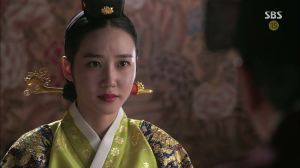
Born in the Hong family who had served in the government, Queen Heongyeong/Heonkyeong (헌경왕후), or widely known as Lady Hyegyeong, was chosen to become the consort to Crown Prince Sado at the age of nine. She entered the court and began the life of a woman of the palace. She bore four children: Crown Prince Uiso who died early, Jeongjo, and two princesses Cheongyeon and Cheongseon. Her fate changed with Sado’s illness and descent into lunacy, which caused his own demise in the hands of Yeongjo, Sado’s own father. Lady Hyegyeong nearly committed suicide but for the sake of her son, she decided to stay alive and protect the future king. She was bestowed with the title Hye Bin (혜빈) after Sado’s death and her sad life seemed never ending when Jeongjo, then a Crown Prince, was legally declared as the son of Crown Prince Hyojang, Prince Sado’s elder brother. This meant that Lady Hyegyeong no longer had any relationship with her own son by law, thus reclining her right to become a Queen Dowager when Jeongjo reigned. Nevertheless, she was loved dearly by her son, although marked with several rifts thanks to Princess Hwawan and Queen Jeongsun’s involvement.
Her natal family suffered greatly due to the political rifts between the two affinal families: Pungsan Hong and Gyeongju Kim clans. Jeongjo bestowed her residence with the name Hyegyeong-gung (혜경궁), hence she would be addressed as Lady Hong of the Hyegyeong-gung (혜경궁 홍씨). She penned The Memoirs of Lady Hyegyeong to shed the truth on the events surrounding her family as well as serving as a reminder to her grandson, King Sunjo. She passed away 15 years after Jeongjo’s death when she was 81 years old Sunjo gave her the posthumous title Heongyeong Bin (헌경빈). After Sado was elevated posthumously to the rank of a king as Jangjo, Lady Hyegyeong was also declared posthumously as Queen Heongyeong.
Portrayed by:
- Kyun Mi-ri in the drama Yi San (MBC, 2007)
- Jung Ae-ri in the drama Eight Days (CGV, 2007)
- Kim Sung-ryung in the movie King’s Wrath/The Fatal Encounter (2014)
- Park Eun-bin in the drama Secret Door (SBS, 2014)
- Moon Geun-young in the movie Sado/The Throne (2015)
Originally one of Queen Inwon’s palace maids, Lady Park (경빈 박씨), known as Bing-ae (빙애), caught Crown Prince Sado’s eyes years before he took her in after Queen Inwon’s death. Since it was considered a taboo for a man to touch someone who belonged to a person above him, Yeongjo was furious that Sado dared to be involved with a maid under Queen Inwon, who was technically his grandmother. Bing-ae was then raised to sukchik, the sixth senior rank, which was the highest rank for a crown prince’s palace maids. She was the object of Prince Sado’s affection and gave birth to a prince and a princess, but Sado’s erratic behaviour caused her to be the target of his wrath as she was often beside him when he lost control over his own self. She was attacked by an angry Sado and mortally wounded, one year before Sado died. Lady Park was posthumously raised to the rank of gwiin after Sado had been declared a king posthumously and further raised to the highest rank bin during Gojong’s reign.
She was the first child of Yeongjo and Lady Yi Youngbin and was loved dearly by her father. Although she was an illegitimate princess by status, Yeongjo’s affection for her had no boundaries and Crown Prince Sado was often left off the hook when Princess Hwapyeong (화평옹주) was there to protect him from Yeongjo’s anger. She was so loved that she continued to stay in the palace after she was married. However, she passed away at a young age of 22 during childbirth, leaving behind her grief-stricken father Yeongjo.
Born as the fifth daughter of Yeongjo and Lady Yi Youngbin, she was neglected by her father, probably because of his disappointment that she was not a prince although she inherited her mother’s beauty. Sado was exceptionally fond of her as she was in the same situation as him, not getting enough love from their father, Yeongjo. He was close with his older sister but Hwahyeop (화협옹주) contracted measles before dying when she was 19. Sado was affected with his sister’s death, leading to his worsened health.
Born as Yeongjo’s eighth daughter with his concubine Lady Yi Youngbin, she was the favourite daughter of Yeongjo, unlike her older brother, Crown Prince Sado. After the death of Princess Hwapyeong, Yeongjo switched her affection towards Hwawan (화완옹주) and she grew loved by her father. Sado usually acted nonchalant around her but when he lost control over himself, he often threatened her into helping him and acting like a mediator between his wishes and Yeongjo. Hwawan then married Jeong Chi-dal and gave birth to a daughter who died prematurely, but her husband soon passed away. She adopted a boy from her husband’s family, Jeong Hu-gyeom. Hwawan returned to the palace and exercised great authority and used her status as Yeongjo’s favourite daughter to gain control in the court. She was not fond of Lady Hyegyeong and tried to put a distance between the grand heir (later King Jeongjo) and his mother. Her son Hu-gyeom enjoyed the privilege of having an influential mother, who even tried to oppose Jeongjo’s enthronement after Yeongjo’s death. She was exiled and had her status demoted to a commoner after Jeongjo ascended to the throne. She did not experience harsher punishment out of Jeongjo’s respect towards Yeongjo. Princess Hwawan was later allowed to return to the capital and passed away at the age of 71 during Sunjo’s reign.
Portrayed by:
- Sung Hyun-ah in the drama Yi San (2007)
- Jin Ji-hee in the movie Sado/The Throne (2015)
Queen Hyoui (효의왕후) married the Grand Heir (Jeongjo) when she was nine years old and was invested as the Grand Heir Consort. She became the Crown Princess and then the queen consort after Jeongjo’s ascension to the throne. As she did not have any child, she adopted Lady Park su-bin’s son, who would become Sunjo. Although she was childless, her relationship with Jeongjo was good and she supported her husband with all her heart. The issue was raised from time to time by the ministers but Jeongjo sided with her regarding the matter. She received Yeongjo’s affection as his granddaughter-in-law and lived until she was 69 years old. Queen Hyoui was down-to-earth and rejected all the titles offered for her during Jeongjo and Sunjo’s reign.
Portrayed by:
- Park Eun-hye in the drama Yi San (MBC, 2007)
She was the first concubine selected for Jeongjo, being 13 years old at the time she entered the palace. She was bestowed the title won with the rank bin (원빈 홍씨) and received Sukchang-gung as her residence’s name. She was treated like a formal consort in Chinese court, receiving morning greetings from the ministers and the physicians, and had posthumous titles conferred to her upon her death. Lady Hong suddenly passed away in the following year after her entrance to the palace and Jeongjo himself composed a eulogy for her.
Portrayed by:
- Ji Sung-won in the drama Yi San (MBC, 2007)
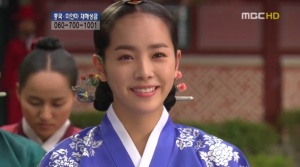
Even though she was the one who gave birth to Jeongjo’s first son, Crown Prince Munhyo, Lady Seong Uibin (의빈 성씨) was the only concubine who worked as a palace attendant, compared to Jeongjo’s other concubines who went through selection process to enter the palace. Lady Seong was loved by the king and gave birth to a son. She was raised to the rank soyong and later, bin with the title ui. After she gave birth to the prince, she was still mindful of her position; she still consoled and held Queen Hyoui with high regard while serving Queen Jeongsun and Lady Hyegyeong faithfully. She observed the customs and maintained a good relationship with the other concubines throughout her lifetime. Her son was officially declared as a crown prince at the age of two and she gave birth to a daughter in the same year; however, the child died before reaching her first birthday. Crown Prince Munhyo died in his fourth year and Lady Seong’s followed his death few months later after experiencing a miscarriage. She was buried in the same site as her son, Hyochanggongwon.
Portrayed by:
- Han Ji-min in the drama Yi San (2007)
She was Jeongjo’s concubine and also the birth mother of Jeongjo’s successor, Sunjo. Lady Park su-bin (수빈 박씨) was elevated to the rank bin when she was 18 and received a name for her quarters, Kasun-gung. Three years later, she gave birth to Jeongjo’s second son. Her son was declared the crown prince and took over the throne after Jeongjo’s death as Sunjo. Lady Park, also known as Lady Kasun (가순궁 박씨), passed away in her son’s 23rd year of reign.
Portrayed by:
- Seo Yoon-ah in the drama Yi San (MBC, 2007)
Born as the daughter of the powerful Sipa member Kim Jo-sun who was also a supporter of Jeongjo, Queen Sunwon (순원왕후) was the prime candidate to become the Crown Prince’s consort, having passed the first two stages of selection process. However, Jeongjo’s sudden death postponed the final stage and she was finally crowned as the queen two years after Sunjo became the king. After the regency period of Queen Jeongsun, the dowager at that time, ended, her father’s faction, Sipa, launched a big scale purge of the dowager’s faction, Byeokpa, following Queen Jeongsun’s Catholics persecution. The purge marked the beginning of Andong Kim’s interference in the politics of late Joseon Dynasty. Queen Sunwon gave birth to Sunjo’s eldest son, Crown Prince Hyomyeong, and the prince was loved by his father due to his intelligence. In order to control the Andong Kim’s political power, Sunjo chose Lady Jo from Pungyang Jo’s clan to become Hyomyeong’s consort. The king declared the beginning of Prince-Regency when Hyomyeong was 19 but the prince suddenly passed away in the fourth year of his regency. Sunjo died four years later, following his son’s death. The throne was inherited by Hyomyeong’s son, Heonjong. Since the new king was only 8 at that time of his coronation, Queen Sunwon became the regent in her grandson’s stead and used her power to choose the king’s consort among her clan members. Heonjong was married to Lady Kim, who was also known as Queen Hyohyeon.
But then, Heonjong passed away without any issue and with Andong Kim’s support, it was decided that the new king would be Yi Won-beom, Crown Prince Sado’s great-grandson through his son, Prince Euneon. Queen Sunwon ordered for him to be bestowed with the title Prince Deokwon-gun and she adopted him in order to ensure his legitimacy as the next king. Prince Deokwon ascended the throne as Cheoljong and his consort was chosen among the Andong Kim clan by Queen Sunwon, who acted as a regent again. With the king under their control, Andong Kim clan enjoyed immense power in the Joseon court until Queen Sunwon’s death at the age of 69.
Queen Sinjeong (신정왕후) was betrothed to Crown Prince Hyomyeong when she was 11 and gave birth to the Grand Heir (future Heonjong) at the age of 18. Her husband suddenly passed away during his regency term. As a result, her son was made the Crown Prince and rose to the throne after Sunjo’s death. Her mother-in-law, Queen Sunwon, continued to use her influence in securing her clan’s power in the court as the most senior member of the royal family. Queen Sunwon’s death caused Queen Sinjeong to be elevated to the rank of Grand Royal Queen Dowager and gave her the power to dictate who would be the next king, since Cheoljong died without any heir.
She adopted the young Yi Myeong-bok, the second son of Prince Heungseon and made the boy as the next king of Joseon, Gojong. As Gojong’s adopted mother and the most senior member of the royal family, she acted as a regent in the beginning of Gojong’s reign. Once Prince Heungseon-daewongun received his title as the king’s father, Queen Sinjeong handed over the authority to him and stepped back. The members of the Andong Kim clan, who were still dissatisfied after they were driven out of power by Queen Sinjeong, concocted a rumour that the dowager wanted to choose Gojong’s consort among her clan Pungyang Jo. She lived until she was 83 and she was buried beside her husband, posthumously bestowed the title Munjo, in Donggureung.
Portrayed by:
- Kim Yong-rim in the drama Empress Myeongseong (KBS2, 2001)
- Jung Hye-seon in the drama Dr Jin (MBC, 2012)
Since Heonjong’s first queen consort, Queen Hyoyeon, passed away, a new queen was chosen after the mourning period ended. Queen Hyojeong (효정왕후) was 14 when she married Heonjong, but her husband died five years later without any heir. She became the Queen Dowager at a young age of 19 when the next king, Cheoljong, rose to the throne. After Queen Sunwon’s death, she was elevated to the rank of Royal Queen Dowager. Together with Queen Dowager at that time, Queen Cheorin, Queen Hyojeong raised a young court attendant at the Dowager’s residence. She was raised to the rank of Grand Royal Queen Dowager following Queen Sinjeong’s death. She died at the age of 73 and held the title Myeongheon (명헌) during her years as a dowager.
She was another consort from the Andong Kim clan, chosen by Queen Sunwon to become Cheoljong’s wife. Her marriage was arranged by her clan in order for them to accumulate wealth and power from their status as the royal affinal family. Queen Cheorin (철인왕후) did not side with her family since she had no interest in politics. She was described as a woman of few words and did not show her feelings to others easily. She became Queen Dowager Myeongsun (명순대비) when Gojong reigned and passed away when she was 42 years old. A son was born from her relationship with her husband but the child died in his sixth month.
The last princess of Joseon Dynasty, she was the only daughter of Gojong with his concubine, Lady Yang gwiin (귀인 양씨). Since her mother’s place was named Boknyeong Hall, the princess was known as Her Young Highness of Boknyeong Hall (복녕당 아기씨). Two months after her birth, Gojong brought her to stay with him in his quarters, Hamyeong Pavilion. Although the king had 13 children altogether, only four of them survived the childhood and Deokhye was the only princess. Gojong doted on her and set up a kindergarten inside Deoksu Palace for her to attend with the other noble families’ daughters. Fearing that Princess Deokhye might be taken into hostage by Japan and forced into political marriage with Japanese just like her brother, Crown Prince Uimin, Gojong made arrangements for her to be married to Kim Jang-han, nephew of a court attendant. However, the secret engagement did not last long with Japan’s interference in the matter. Gojong passed away in 1919 and the princess moved into Changdeok Palace in 1920, where the late king’s Spirit Hall was situated. She started her primary education in a school inside the palace, together with the other three students and got admitted to a public school in 1921, the same year she received her official title, Deokhye (덕혜옹주).
Sunjong was informed in 1925 that Deokhye was to be brought to Japan in order for her to continue her studies. Arrangements were made and the princess was admitted to Gakushuin. In the 3rd year of 1926, Deokhye and Uimin were summoned for a royal audience with Sunjong but they had to return to Japan few days later. Sunjong passed away in the following month and Deokhye could not attend the funeral since she was only permitted to make a short trip back to Korea. Her mother, Lady Yang, passed away in 1929 and Deokhye was not given the permission to mourn for her mother since Lady Yang was not a part of the royal family, thus forced to shorten her trip home again. She showed signs of nervous breakdown and moved in with Crown Prince Uimin in 1930 before being admitted into a hospital for treatment. She recovered and continued her studies in Gakushuin.
Although she was engaged back in Korea, Japan pressured the royal family of Korea into giving the permission for Princess Deokhye’s marriage with a Japanese man, just like what Gojong feared before. Her match was So Takeyuki, a Japanese nobleman who was a 3rd year student at the University of Tokyo, and the marriage ceremony took place in 1931 in Japan. Deokhye gave birth to her first and only daughter, So Masae, in the following year. She was plagued with mental illness after giving birth to her child and underwent treatments in mental clinics. Her husband divorced her in 1955 and her condition grew worse after her daughter, Masae, committed suicide in 1956.
Princess Deokhye went back to Korea after receiving an invitation from her homeland’s government and reunited with her classmate in kindergarten and primary school, Min Song-ah, and her wet nurse, Mrs. Byun Bok-dong. She was admitted to SNU Hospital after meeting her sister-in-law, Empress Sunjeong. She was formally named as Yi Deok-hye and was discharged from the hospital after her condition became stable. She lived in Sugang Hall, situated in the compound of Deoksu Palace. Her ex-husband went to see her but his request was rejected. Her later years were filled with trips to various hospitals and Princess Deokhye passed away in Sugang Hall in 1989. She was buried in Hongyureung, which was also the final resting place for Gojong and Sunjong.
Portrayed by:
- Kim So-hyun & Son Ye-jin in the movie Princess Deokhye/ The Last Princess (2016)

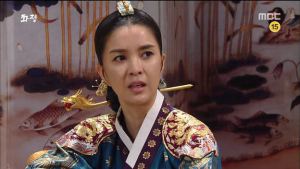

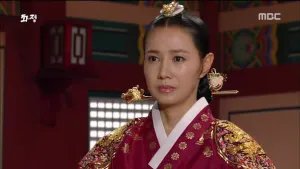
Hi Mimi! I was reading the biography of Queen Hyeojong and I was surprised to read that she raised together with Queen Cheorin a young court attendant. How could they do that if the attendant wasn’t the daughter of one of them? Also, how could they keep this a secret from the rest of the royal family? Please solve my question and tell me more about the attendant if you know.
It was recorded that she did so to cure her boredom, and it did not really violate the palace’s rules since the attendant had to live inside the palace. She did not formally adopt the court lady so it was possible, and the lady would go on to be one of the last court attendants of Joseon named Cheon Ilcheong. Forgive me but I think I did a mistake, because there was another attendant Queen Cheorin raised at that time, and the said lady would also become part of the last court attendants named Jo Haseo.
Also, can you tell me the ranks that Queen Insoo held during her lifetime? I was always confused with them. It would be really helpful to me to answer this. By the way, I’ve never had so much information about the royal ladies of the joseon dynasty anywhere and this post always helps me whenever I want to search for a queen or a concubine. Keep up the good work!!!
The English translation of the titles might be the reason why it can get confusing, but although she is known as Queen Insoo, she was never a queen consort during her lifetime. Her titles and ranks are as follows:
I have read in a site called ”royal ark korea”, particularly in the page ”korea3”, that Queen Jeonghyeon (Seongjong’s third lawful wife and mother of Jungjong) died by taking poison. This was the first time I had ever seen that and I was taken aback. What did she do to die like this? You don’t mention it in her biography. I don’t think this is true, but anyway I wanted to ask you.
Sorry, I’ve made a mistake. It is the page ”korea4”
I checked it and I saw that it is the page “korea3”. I am sorry again.
Also, can you tell me the relationship Queen Insoo had with her father-in-law, mother-in-law, husband, children, daughters-in-law and her two grandsons (Yeonsangun and Jungjong)? In the drama “Queen Insoo” her relationships she had with her in-laws and her family may be depicted differently from the historical reality. So, if it’s not tiring for you and if there are information please tell me.
This is seriously incredible! Thanks for putting this out here!
I have a question about Queen Jeonghyeon. Do yow know how she died? ‘Cause I have read in a site called ”royal ark korea”, particularly in the page ”KOREA3” that she died by taking poison. This was the first time I had ever seen that and I was taken aback. What did she do to die like this? You don’t mention it in her biography. I don’t think this is true but anyway I wanted to ask you.
There was no mention of the way she died, but her son King Jungjong was still alive at that time, so it was very unlikely she died by taking poison.
Please answer to me as soon as possible.
Thank you. I have some questions. 1) Do you know which of Yeongjo’s consorts was his most favourite one? 2) from which ranks of royal concubines did Yeongjo’s consorts (Only Lee Jeong-bin, Jo Gwiin and Moon Suk-ui) ”pass by”? 3) when king Yeongjo was invested as Royal Prince Successor Brother (wangseje), queen Jeongseong was installed as Royal Princess Successor Sister-in-law or something like that?
1) I don’t exactly know, but judging from the accounts and the modern interpretations of Yeongjo’s family, it has to be Lee Young-bin and Queen Jeongseong, because he spent years with them.
2) Lee Jeong-bin : Sohun (as Crown Brother’s concubine) –> Sowon (posthumous) –> Bin (posthumous)
Jo Gwiin : Sukwon –> Sukui –> Gwiin
Moon Sukui : Sowon –> Sukui –> deposed (Munnyeo)
3) Queen Jeongseong became Royal Prince Successor Brother’s Consort (wangsejebin) when Yeongjo became wangseje.
Thank you. I would also like to know when Lee Jeong-bin, Jo Gwiin and Moon Sukui received their titles as royal concubines (I mean which year and answer me only if there are information). Also, since Queen Jeongseong and Lee Yeong-bin were his favourite consorts, then why did he have three more consorts (except for Queen Jeongsun, whom he married because of Queen Jeongseong’s death and thus the inner court needed one queen)? 3rd question: Are there any records about why Queen Jeongseong and Queen Jeongsun didn’t bear any child during their lifetime? 4rd question: Did Lee Jeong-bin had any official rank and title when Yeongjo was still a prince? 5th question: When Yeongjo was still a prince, his children with Lee Jeong-bin (Princess Hwaeok, Crown Prince Hyojang and Princess Hwasun) had the titles of a prince and a princess respectively and how were they addressed when Yeongjo became wangseje? (I’m sorry to bother you with so many questions)
Don’t you think go bo gyeol was the one who became queen jangkyeong in queen for seven days?
Yes, I’m still positive about that since her family name and her uncle’s name matched those of the real Queen Jangkyeong, but unfortunately, the drama’s focus was on Queen Dankyeong and Jungjong’s romance so we didn’t get to see her as a queen onscreen…
Can i ask how other people should treat royal consorts? I watched Dong Yi, and royal consorts were treated almost like queens; they’re highly respected. But I also watched Queen for Seven Days and everyone seems to talk informally to Jang Noksu. Chaekyoung told her once, “How dare you touch me?”, and Jwauijeong called her just “Sukwon” and not “숙원 마마”. I sometimes think maybe it’s because she’s a gisaeng but then Choi Suk Bin is a lowborn and still gets respected so I’m confused 🤔.
Hello!
Royal concubines were supposed to be treated with respect since they were the king’s women and therefore deserved that kind of treatment; however, there were many factors which contributed to the level of respect shown towards them:
king’s affection
the concubine’s origin and status
the concubine’s children
the concubine’s natal family and supporters
the way the concubine rose to the rank
Since you’ve mentioned Dong Yi (Lady Choi sukbin) and Jang Noksu, I’m going to focus on these two.
Dong Yi, despite being of humble origin of a palace maid (aside from the disputed water maid), became a staunch supporter of Queen Inhyeon. It was her support for the queen which earned her the love of Sukjong and the respect of the officials. Plus, she also gave birth to a prince, who would later become Yeongjo. She was also said to be calm and temperate, making people respect her more.
As for Noksu, despite being Yeonsan’s object of affection, she was widely known as a gisaeng in the past prior to her days as the royal concubine. Both maid and courtesan were regarded as lowborns, but palace maids were actually given higher social standing than the courtesans, since they were palace workers and they were considered properties of the king. As for the courtesans, they were still the government’s servants too but with more freedom and unfortunately, more scorn towards their nature of work. Noksu was also viewed as the enabler of Yeonsan uncouth lifestyle, so there’s that too.
Happy New Year!! Long time no see Mimi!
I had a question in mind. Was Queen Jeonghee illiterate? In Queen Insoo, it is shown that she can’t even read or write anything and that her daughter-in-law is her teacher lol! She was so frustrated that Insoo was her educator and I think that she felt inferior towards her. Despite all of that, do you know what was the case in real history? Thank you.
May 2021 be a year full of health, happiness and joy!
Oh and in case you don’t remember me, I am Eleftheria! I just created a wordpress account~
Hahahaha Happy New Year to you too! I was wondering who you are because your username was unfamiliar to me 😆
In real history, it was recorded that Queen Jeonghee once turned down the court’s appeal for her to become the regent during Seongjong’s early reign, with her citing that it would be better for Queen Dowager Insoo to become one, since Insoo could read Hanja (aka Chinese characters). Some took it literally that she could not read the Hanja, but there are also views that it was her own way of being modest. However, there was no way of checking the truth since the dowager regency during her time was held differently from what is portrayed in the dramas; Seongjong would have a private audience with Queen Jeonghee after his discussion with the court, and the dowager would offer her appropriate advice for the young king. Perhaps, one thing for sure is Queen Dowager Insoo’s literacy in Hanja enabled her to write Naehun, which is a guidebook for women education summarizing various texts.
Hi!
Mimi could you check your email? I have sent you something 😉
Oops okay, let me check the inbox!
Sorry, I just knew this post and I am excited reading this. Thank you for your writing. Btw you can add photo of Queen Sunwon and Queen Charin^^
Do you know which concubine was the King Sukjong’s most favorite one? Jang Heebin(Jang ok Jung) or Choi Suk bin(Dong yi)? Kings most loved one
Mimi, do you know if young Prince Yeonsan was raised by his biological mother Deposed Queen Yoon or by his aunt, Princess Consort Seungpyung? In Queen Insoo, it is depicted that Seungpyung raised him because Deposed Queen Yoon was deemed unsuitable for the mother’s role. Did it really happen this way?
In early Joseon, it was not unusual for royal children to be raised outside the palace grounds and/or by royal relatives, like the children of King Sejong. Since Queen Yoon had showed signs of extreme jealousy even during her pregnancy, which led to her being driven to live in the detached palace mere months after Yeonsan’s birth, it might be safe to assume that the young prince was raised by the nannies early on.
It was mentioned that Yeonsan grew up at the house of a high ranking statesman named Kang Hui-maeng and frequently visited Prince Wolsan’s house to recover from minor illness, so he probably grew close with Princess Consort Seungpyeong. He did show her favourable treatment, which also led to unfortunate rumour about them being in a relationship.
It seems strange to me that royal children could be raised outside of the palace and I was shocked when I read what you wrote about Yeonsan growing up in a statesman’s house. I mean, he couId easily harm the little prince if he wanted to… Shouldn’t the King’s children be protected closely because they were his direct issue? Not to mention the crown prince that was meant to become a king one day…
By the way, have you started watching Queen Insoo? I remember you had said to me that you have the drama’s files in your computer. I have started watching The Devil Judge and I’m simply amazed by the whole story!
Kang Hui-maeng was a meritorious subject who was a trusted official ever since King Sejo’s reign, so his loyalty would be taken into consideration when choosing the place to raise the future King. I bet King Seongjong wouldn’t be that careless, right?
Right now I’m not watching any drama. Maybe I’ll just wait for the next drama season hehe
I wonder why in Lady Hyegyeong’s case things weren’t complicated as in Insoo’s case regarding their royal titles lol. Both were married with Crown Princes’ that didn’t eventually ascend the throne, plus their sons were made legally the adopted children of their husbands’ deceased half brothers (lol it’s funny how the two cases are exactly the same). So, how was Lady Hyegyeong addressed by the royal court staff and court officials? I don’t think she ever became Queen Dowager..
I think that despite the two cases being similar, there was one glaring difference that was the circumstances in which their husbands died. This one difference would later give so many reasons for the treatment they received posthumously during their sons’ reign respectively.
Jeongjo was made the adopted son of Crown Prince Hyojang while Seongjong was made the adopted son of Yejong. Crown Prince Hyojang did not even get to rule as a king in his lifetime, unlike Yejong who sat on the throne despite for a short time. When Jeongjo rose to the throne after Yeongjo’s death, his late grandfather left him a will to honour Crown Prince Hyojang and it was appropriate for Jeongjo to raise CP Hyojang’s status to a posthumous king with the temple name Jinjong. The priority was CP Hyojang, plus Jeongjo could not simply go against the order of the preceding king and treat his birth father CP Sado as a posthumous king at the same time. As for Seongjong, his adopted father Yejong was a king and needed no further elevation of status. There was also no other hurdle for him to honour his birth father during his reign, thus the temple name Deokjong for CP Uigyeong. The consorts’ titles also followed the appropriate designation and rank befitting their status as the legal wife of the late king, bearing the title Queen Dowager in their lifetime.
As for Lady Hyegyeong, despite not getting the Dowager title during her lifetime, her status was high and placed between the Dowager, Queen Jeongsun, and the queen at that time, Queen Hyoeui.
Ooops I realised I’ve made a mistake just now lol. I said that their sons were legally made the adopted children of their husbands’ deceased half brothers, but actually Yejong was Crown Prince Uigyeong’s full brother lol😆.
You should add Shin Hye-sun’s photo as Queen Cheorin
In wikipedia it is stated that Yun Hwa bin (one of Jeonjo’s concubines) conceived but she had an imaginary pregnancy. But, this is actually confusing..imaginary pregnancy means that a woman experiences pregnancy symptoms without actually being pregnant with a child..so how is that Yun Hwa bin conceived a child without being pregnant? 😆 lol That’s even stated in the korean wikipedia..Mimi, do you perhaps know what’s going on with that fact? lol
The Veritable Records of Jeongjo mentioned the set up of a temporary office that was the Delivery Office for Lady Yoon in the first month of 1781, but there was no mention of any birth or passing happening until the suggestion made for the disbandment of the Delivery Office in the third month of 1783, more than 20 months after its establishment. There was no mention of the imaginary pregnancy or whatsoever and it is probably a modern conclusion made by going through the documents.